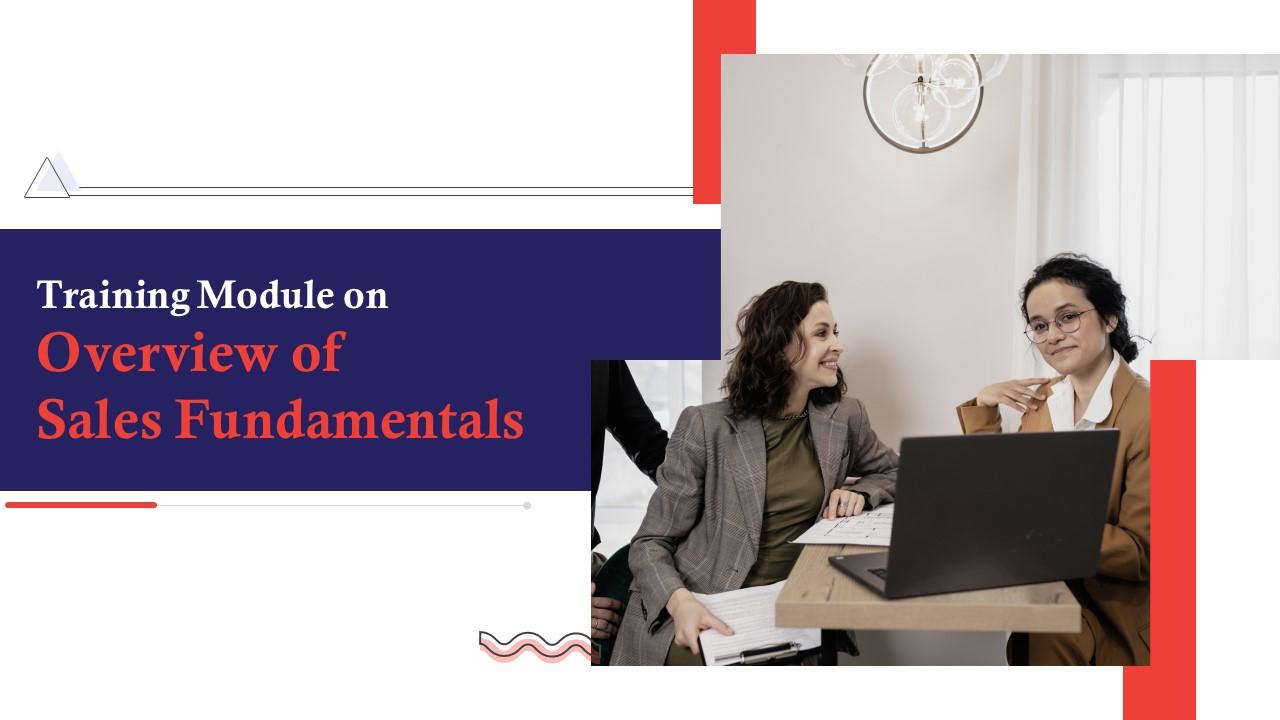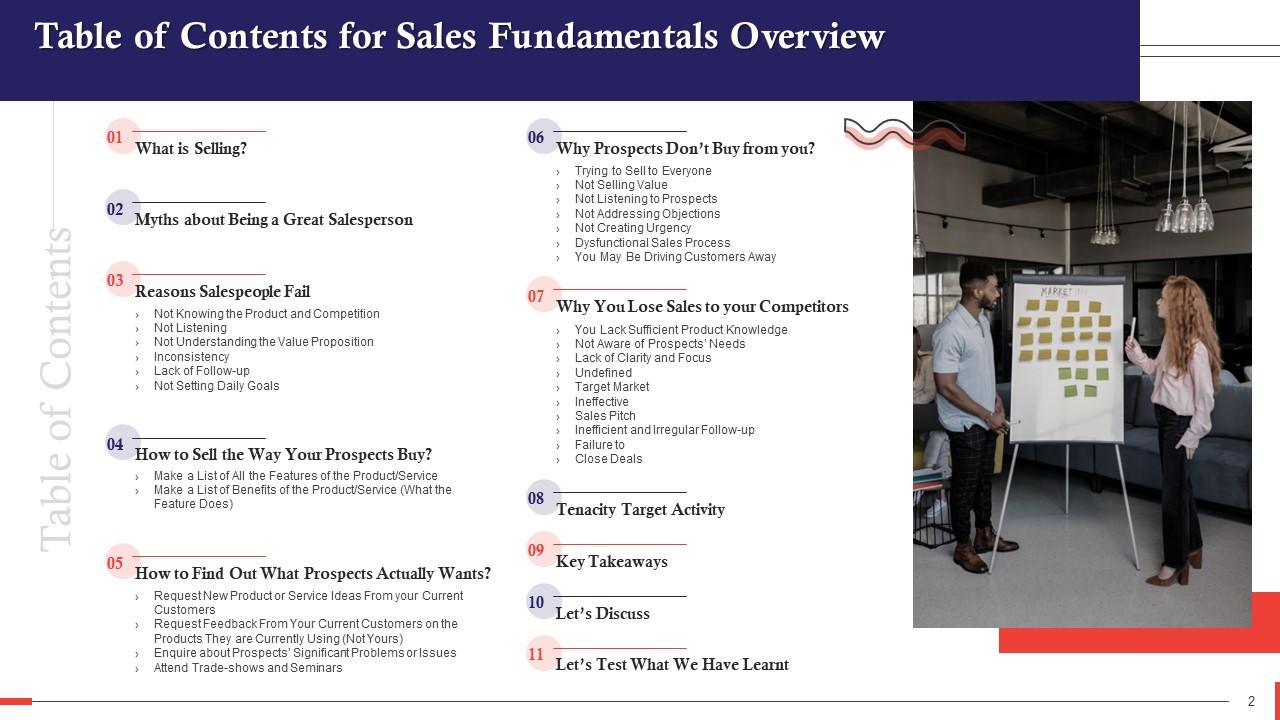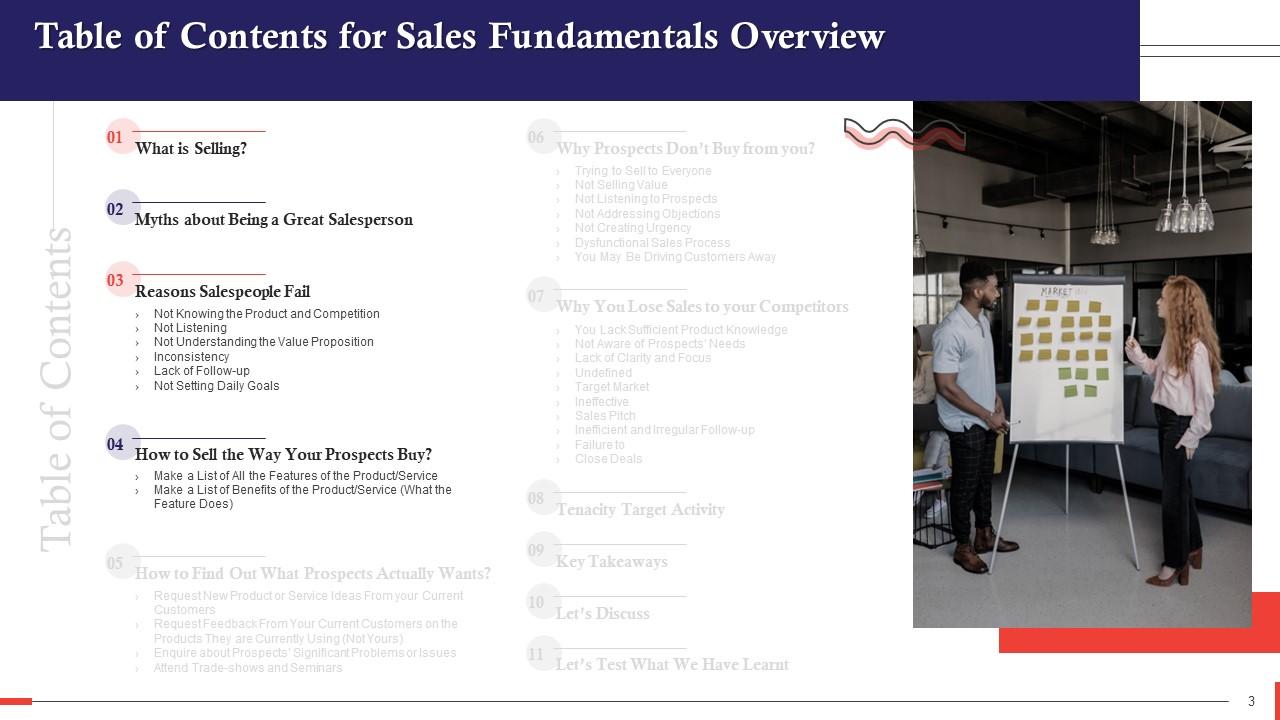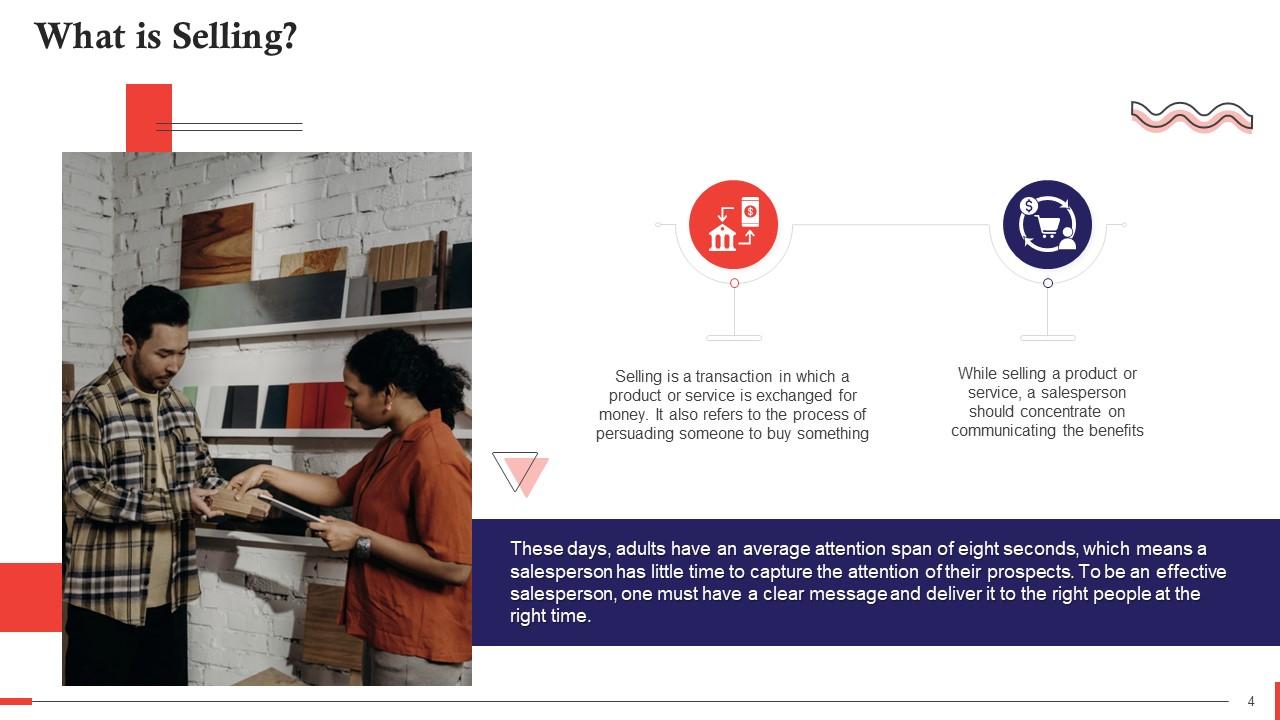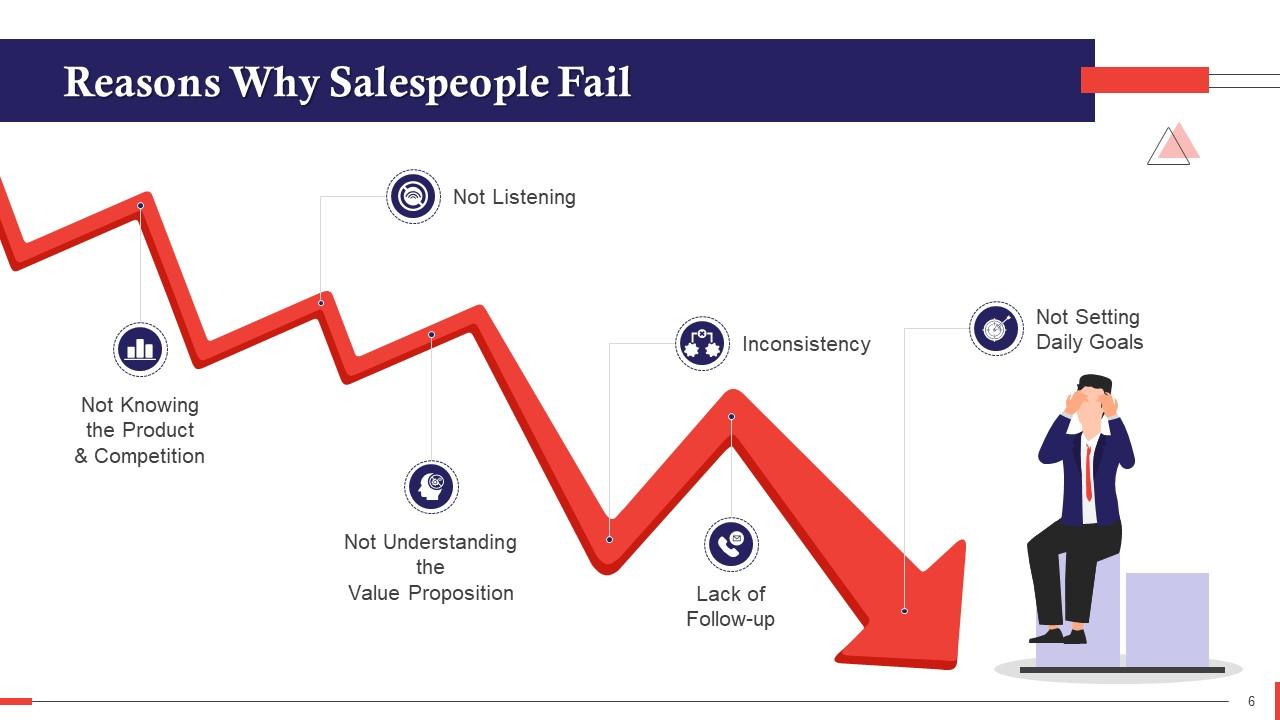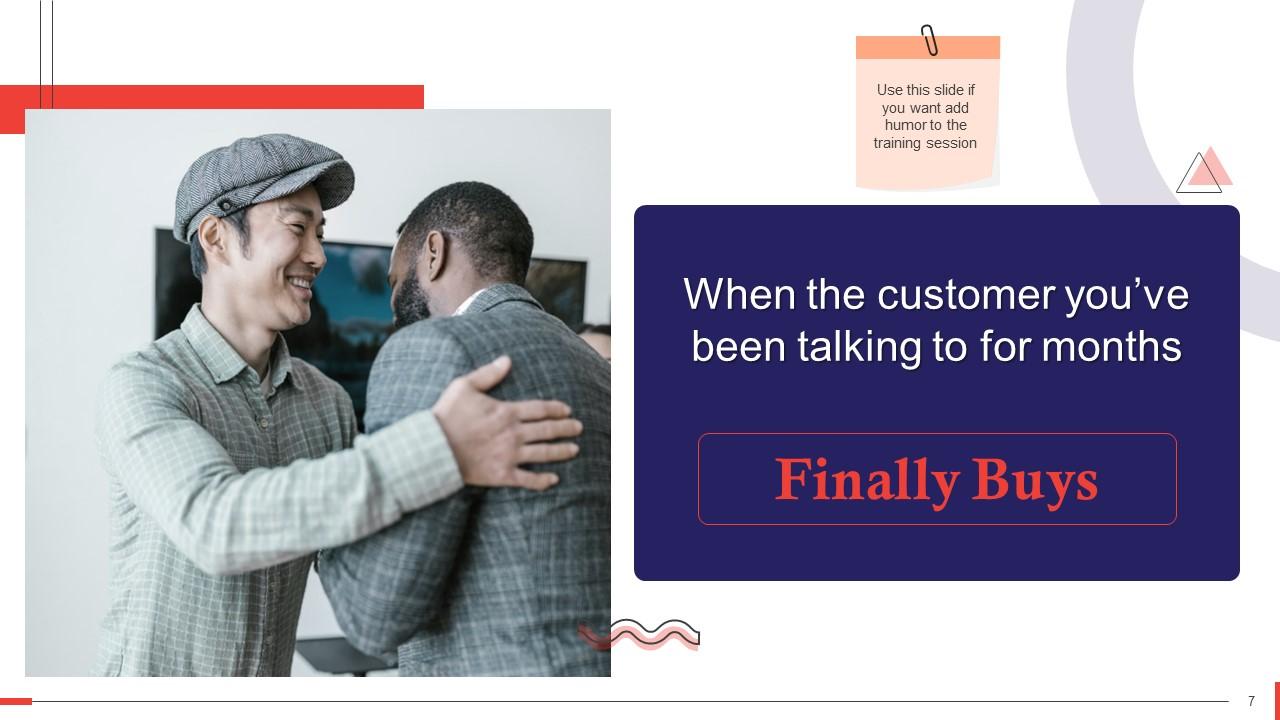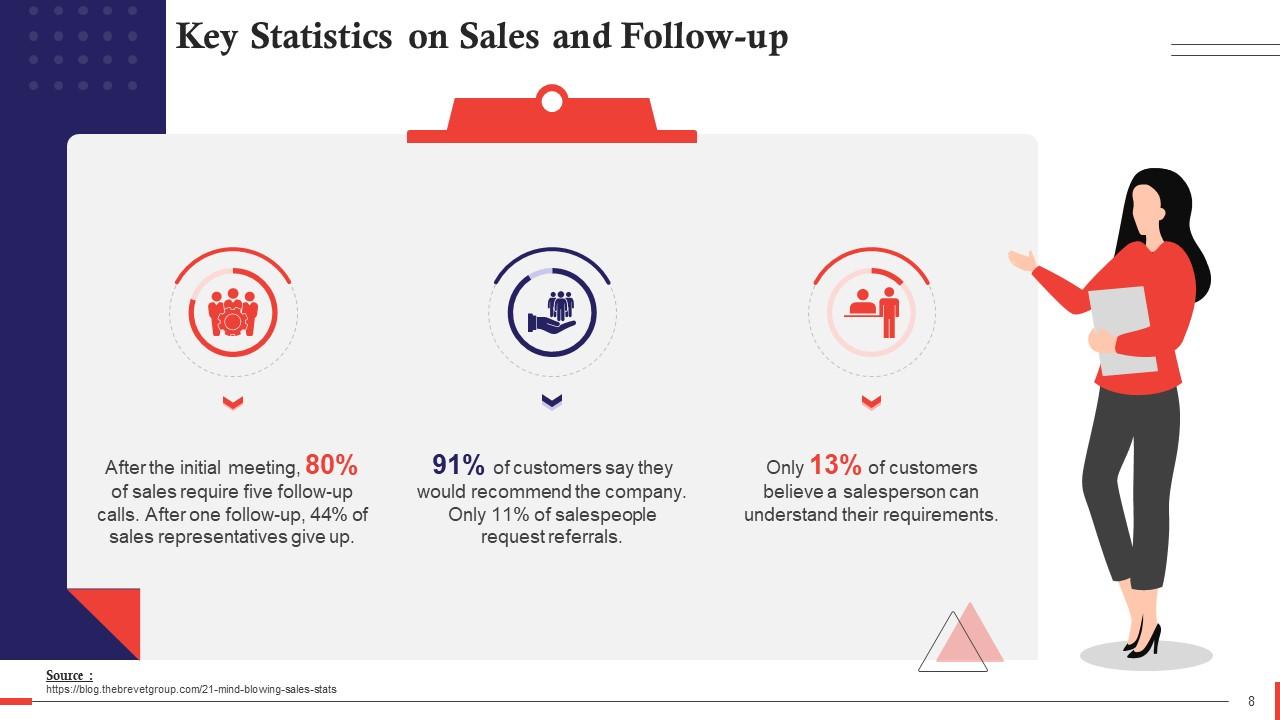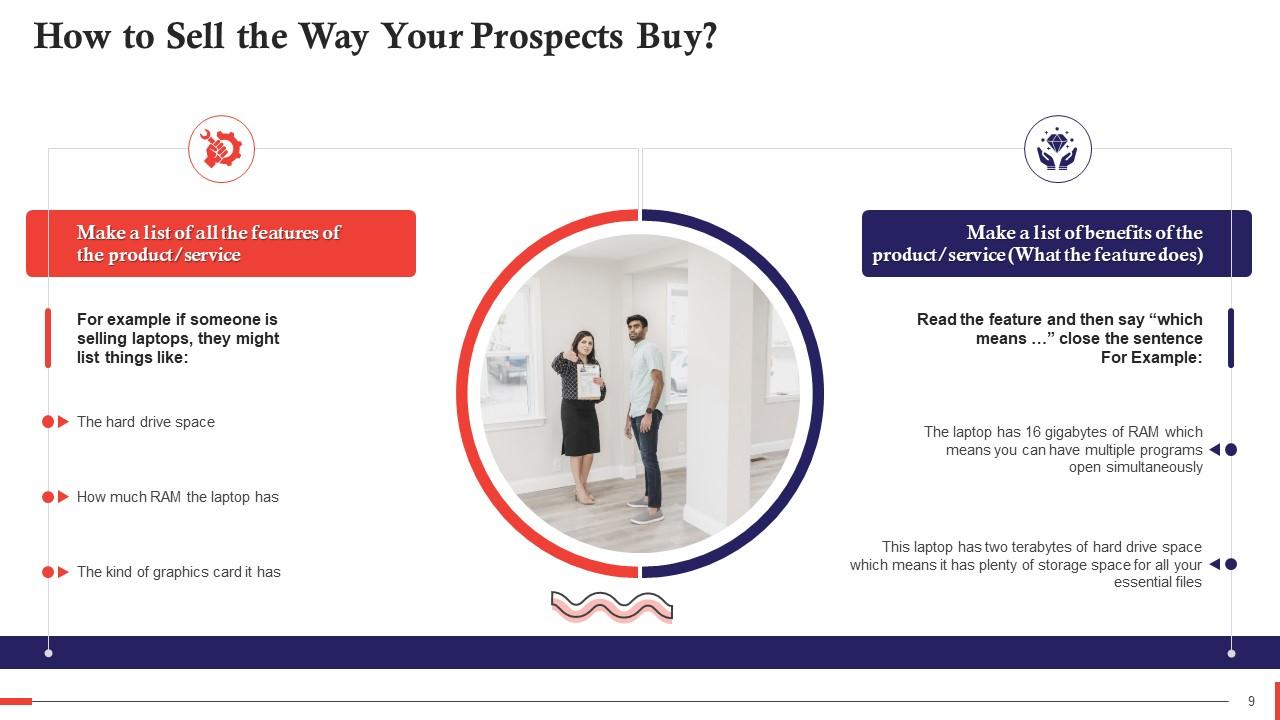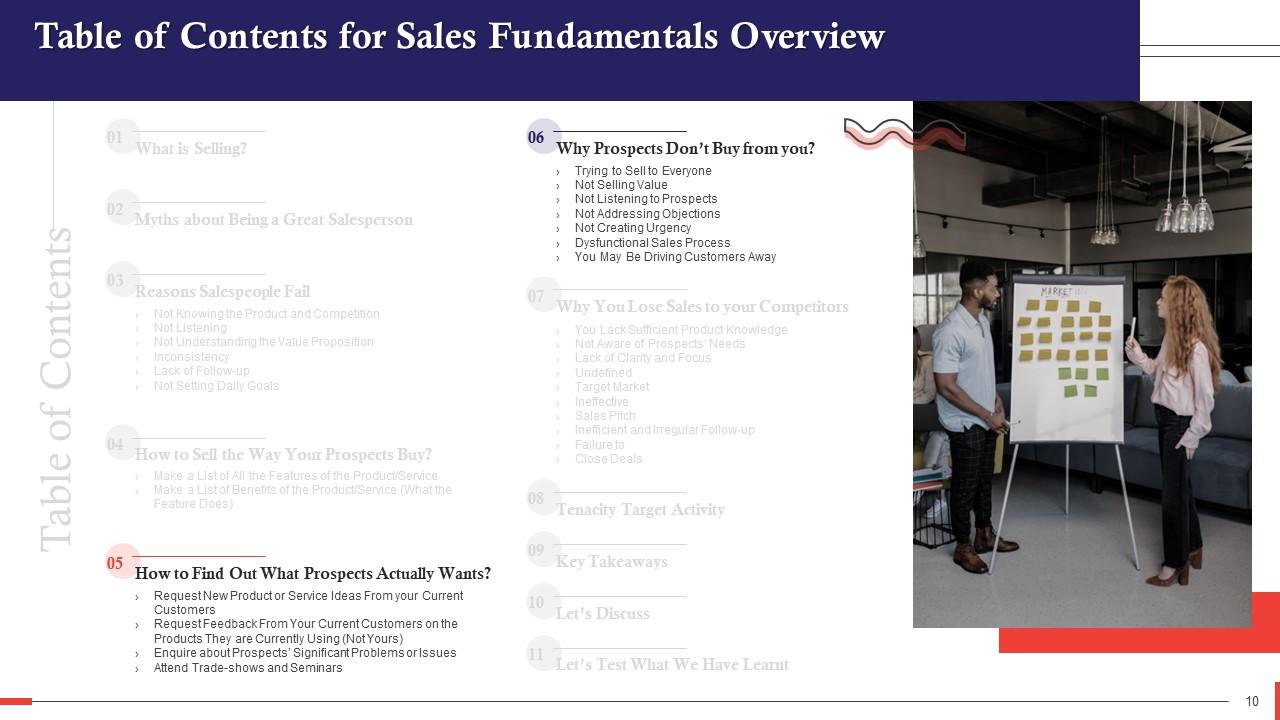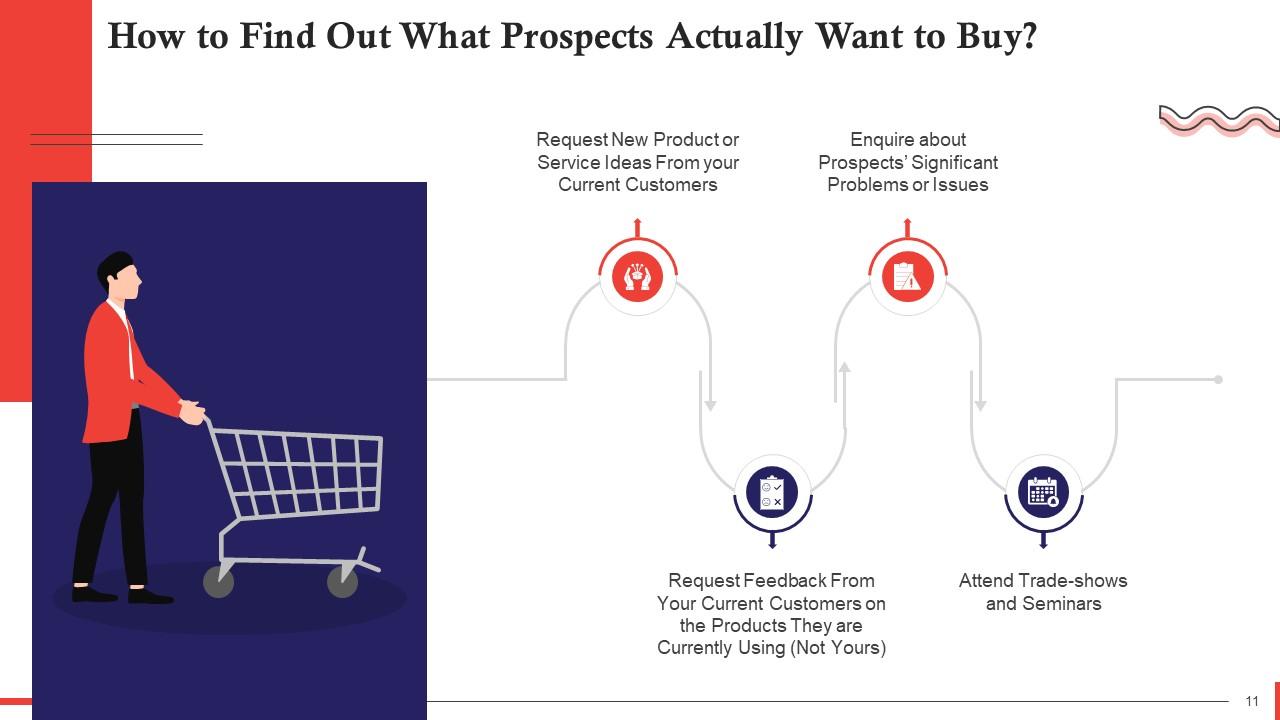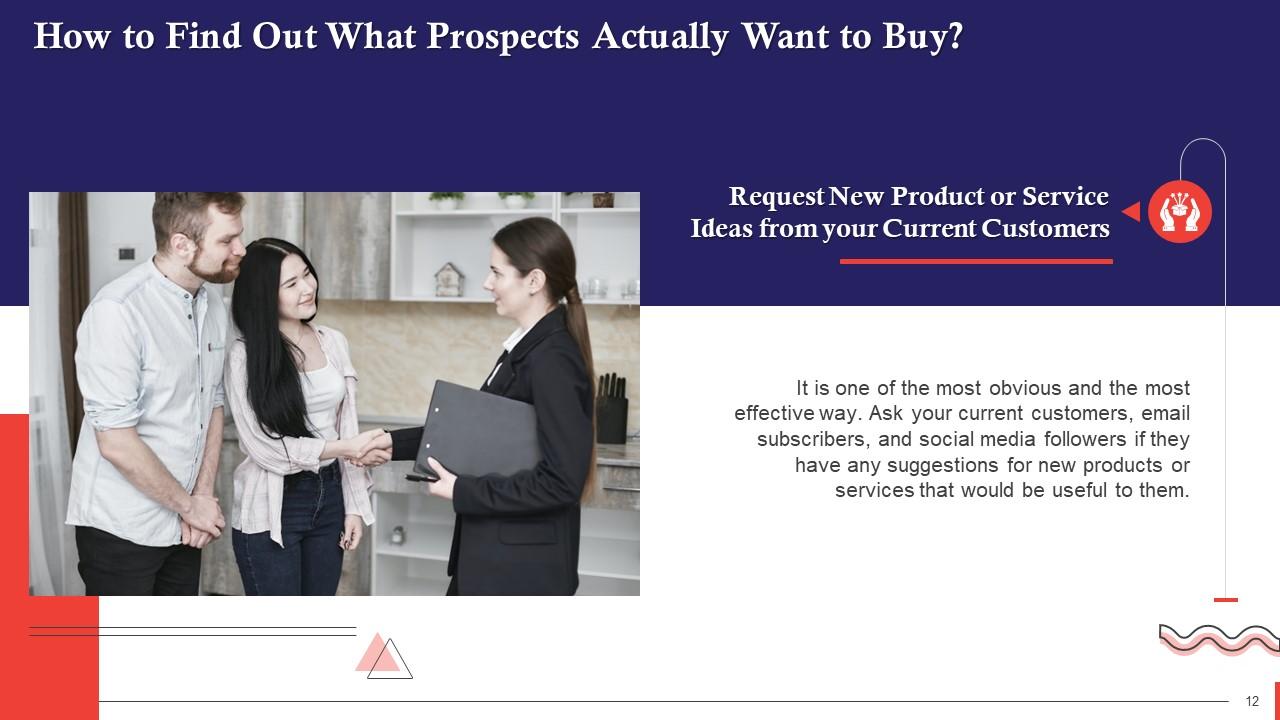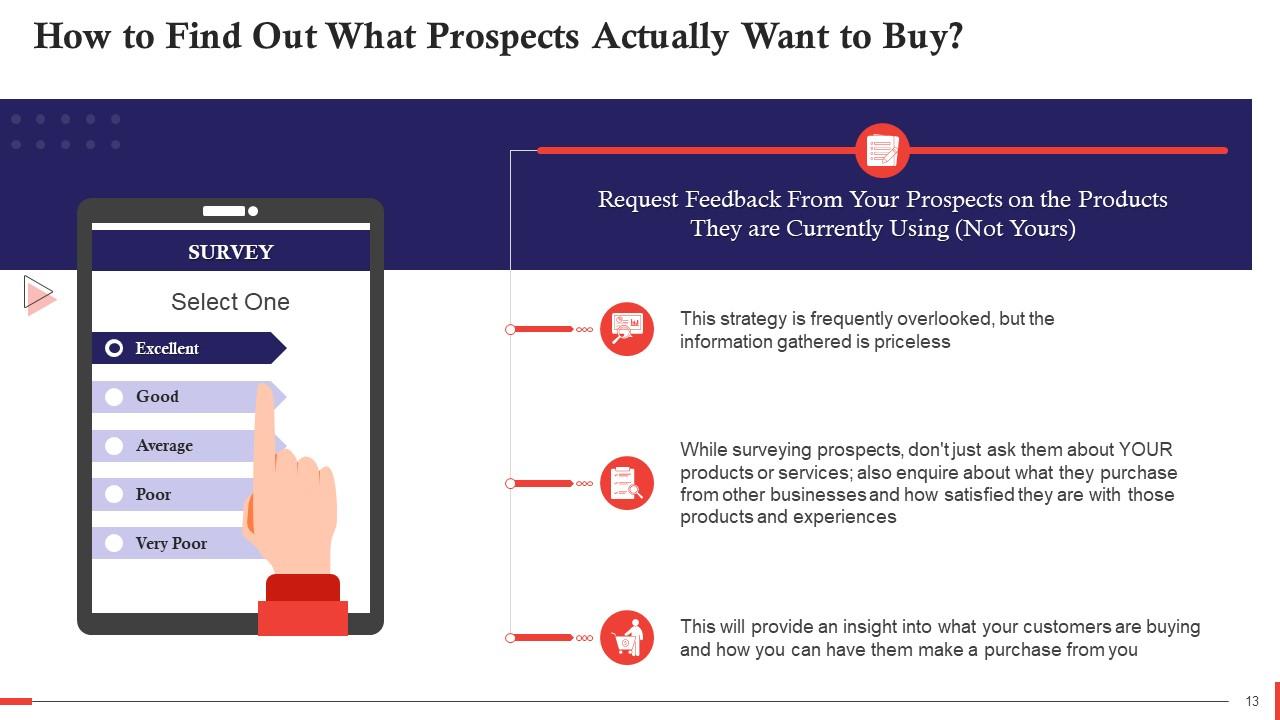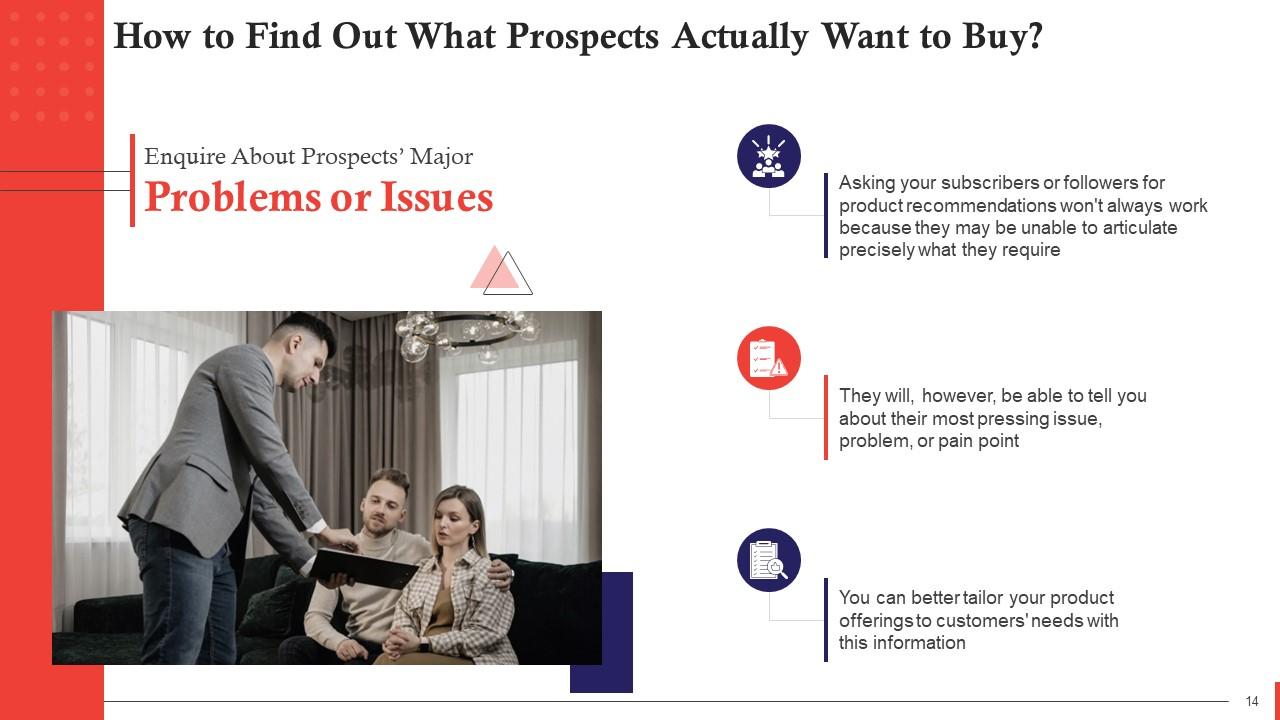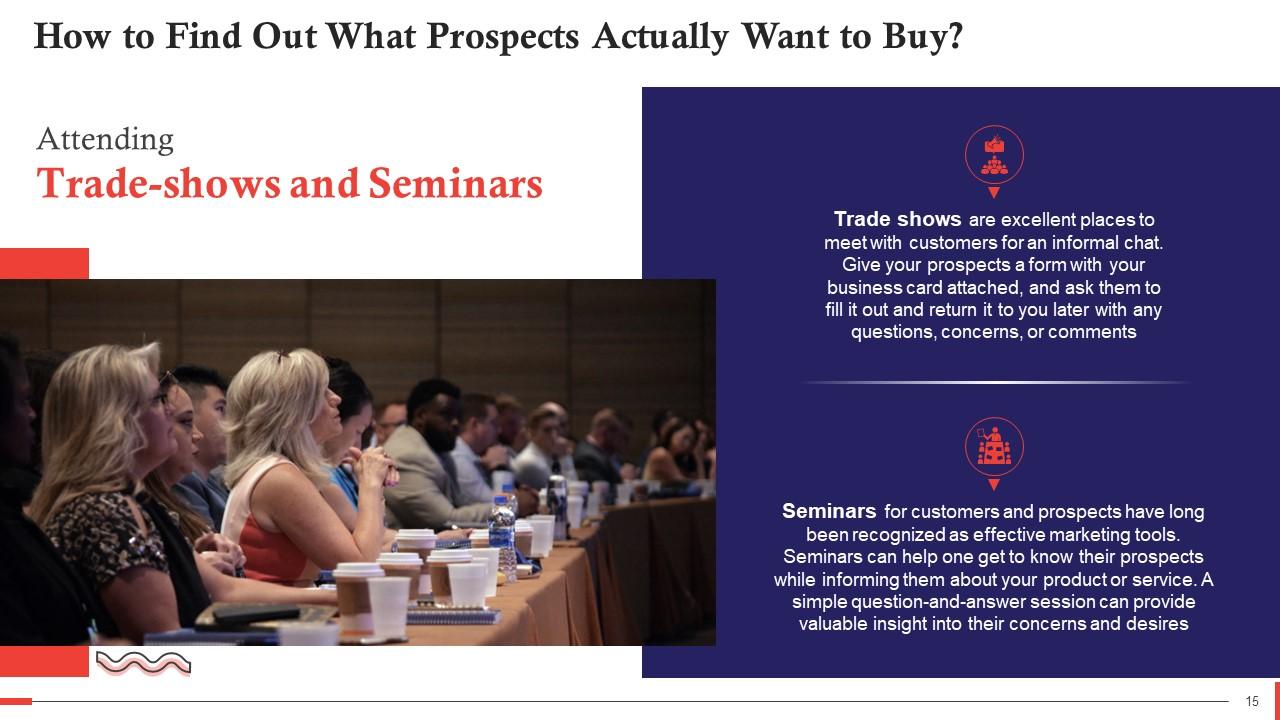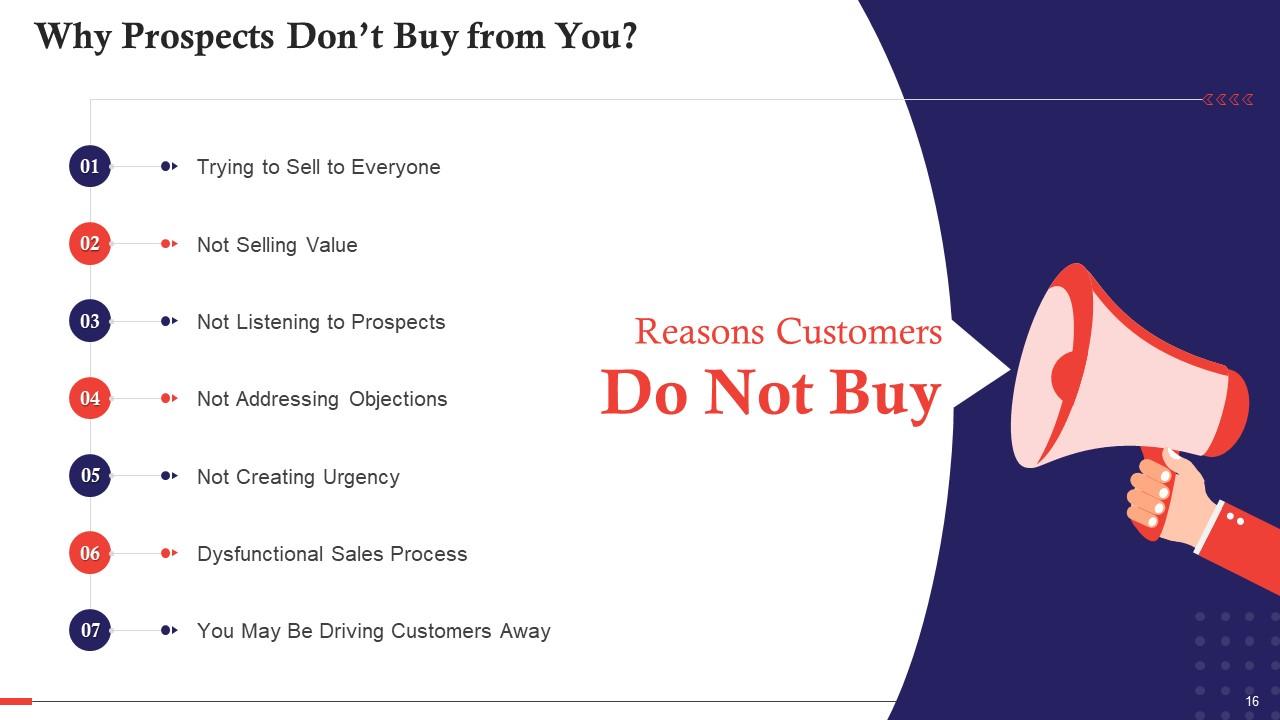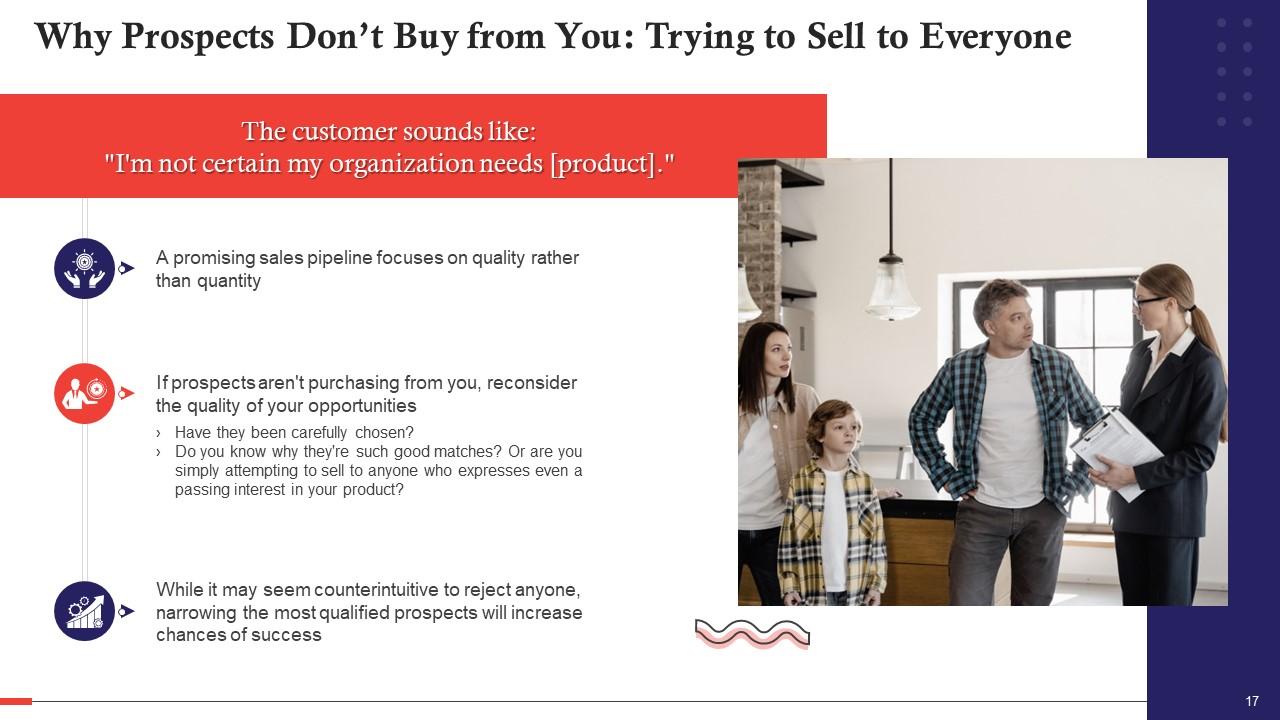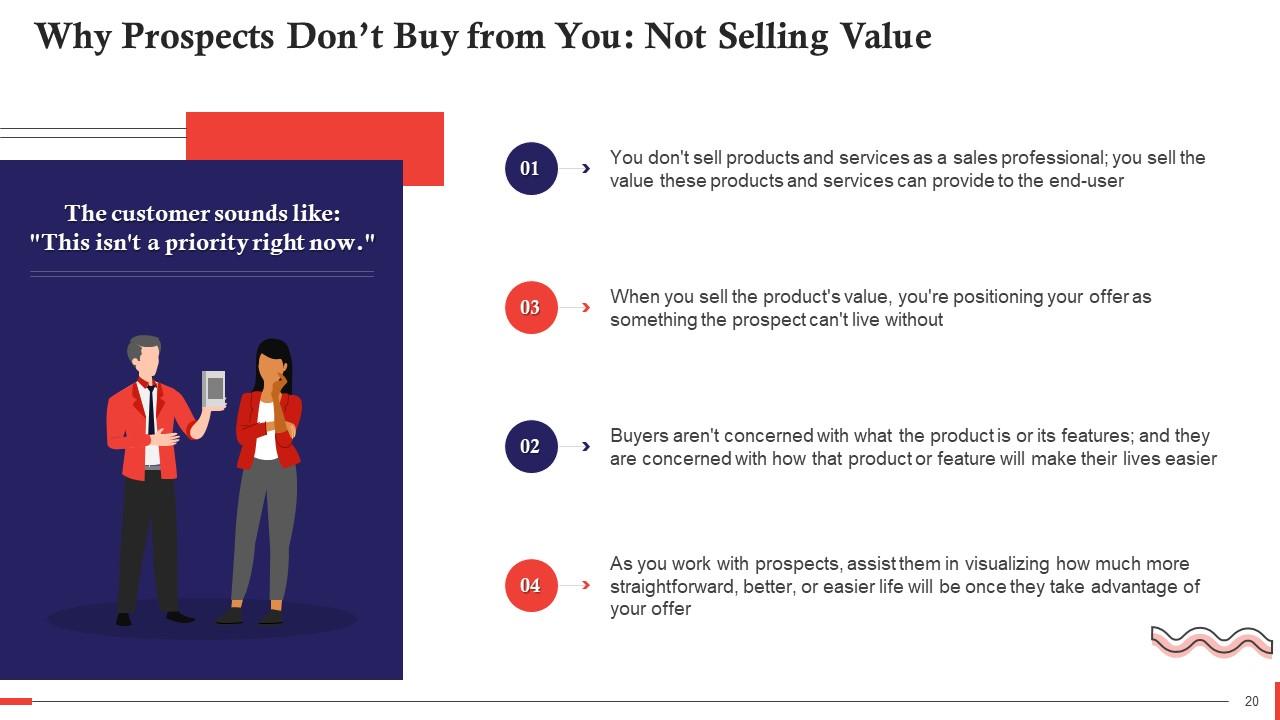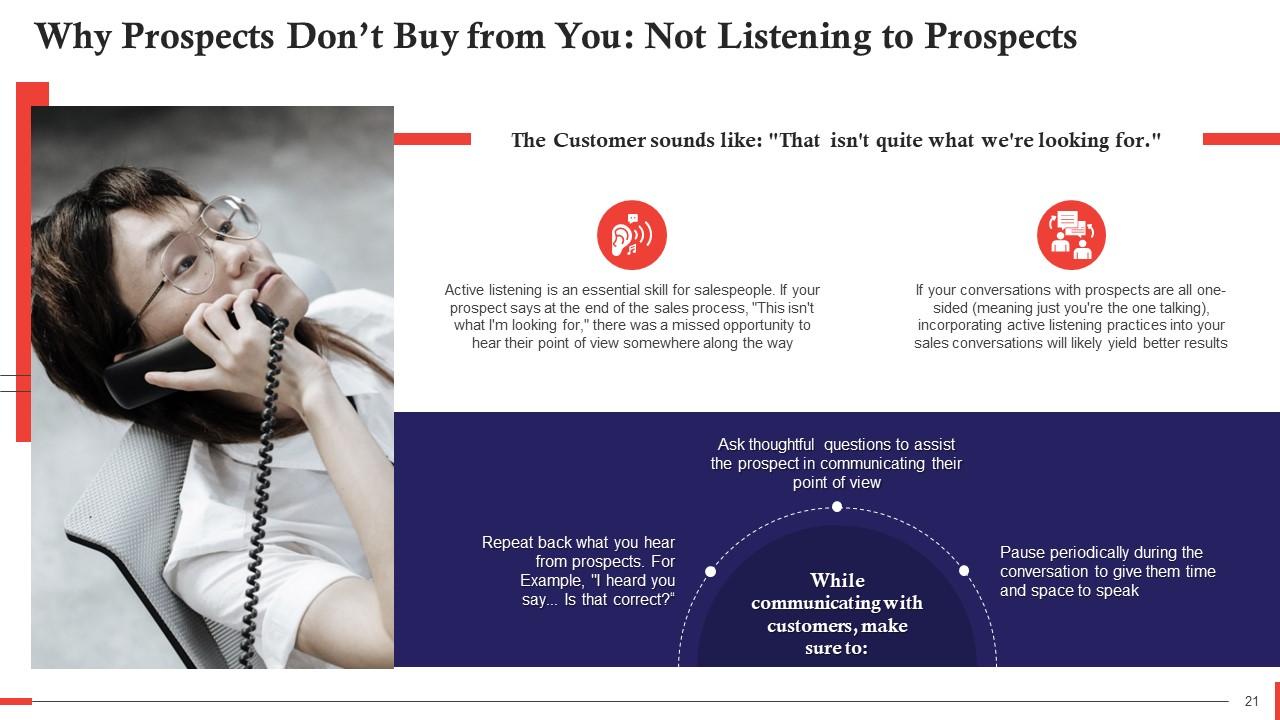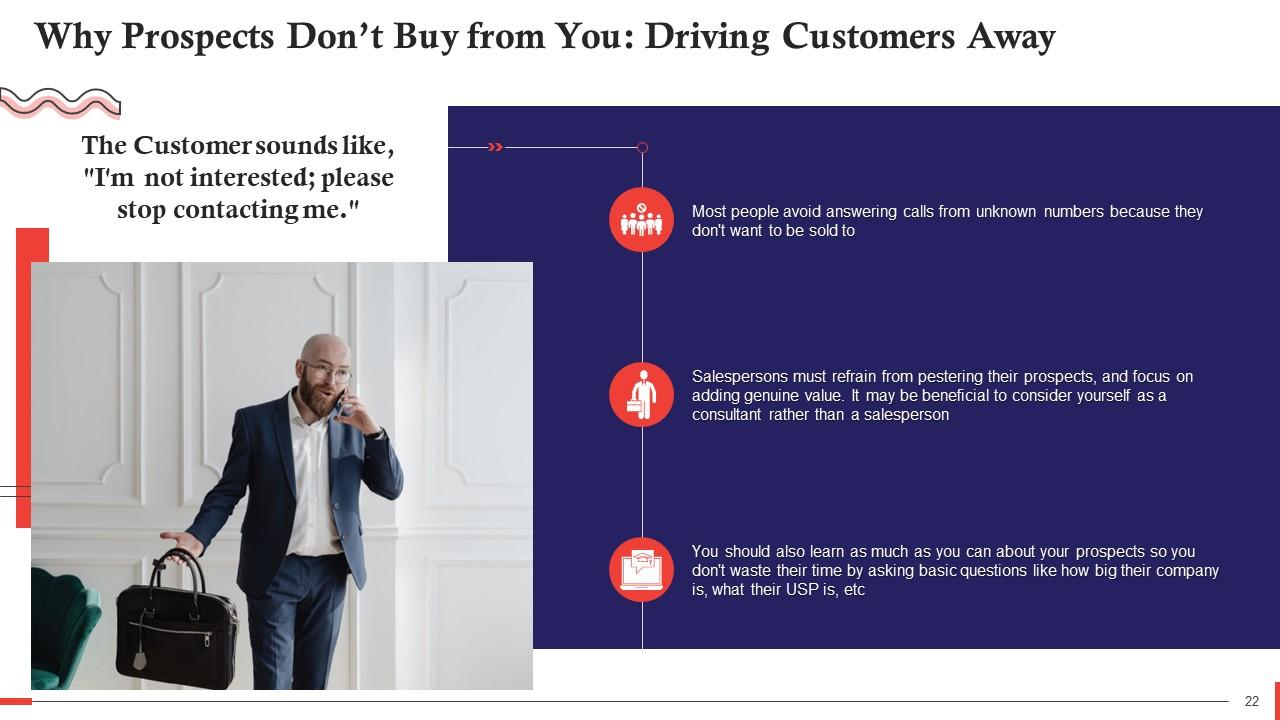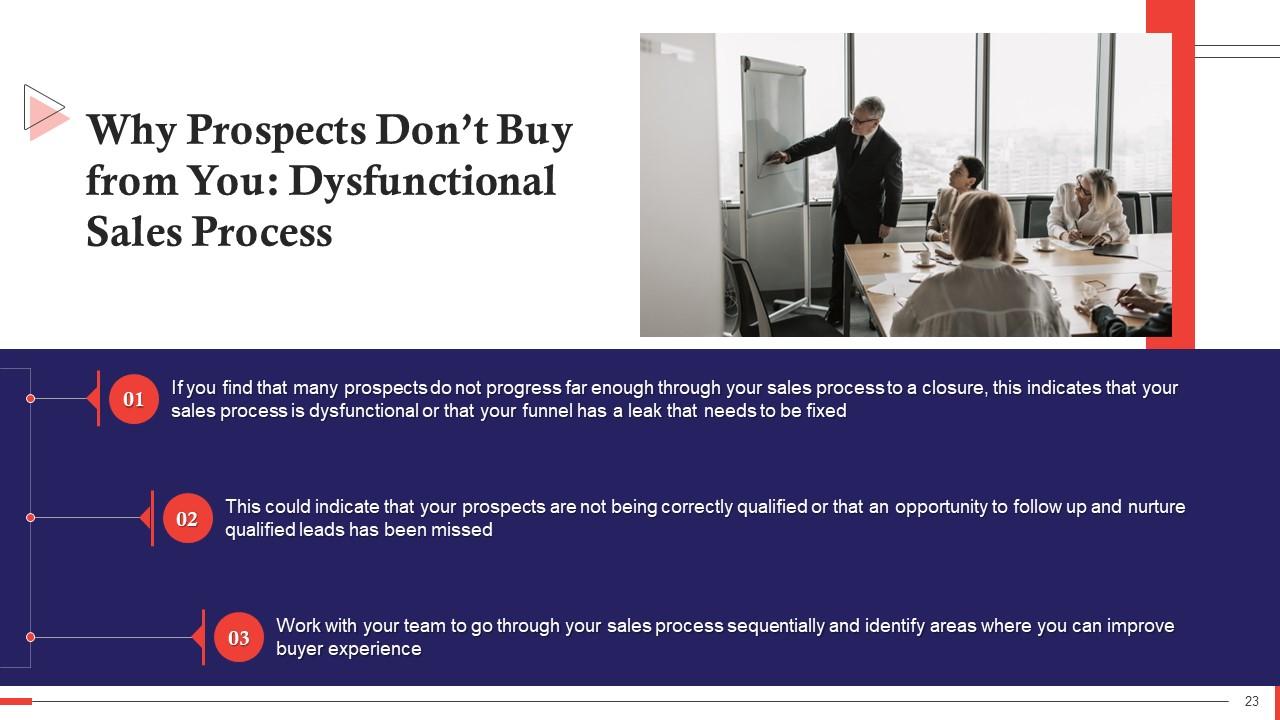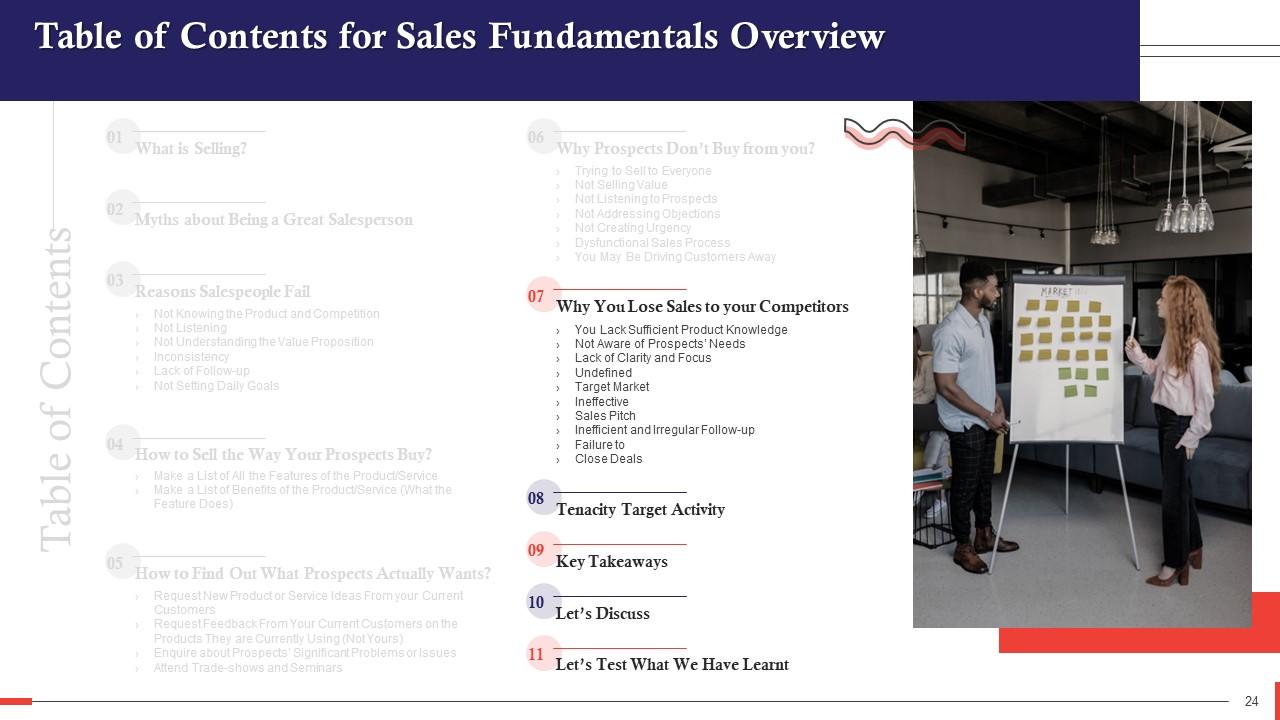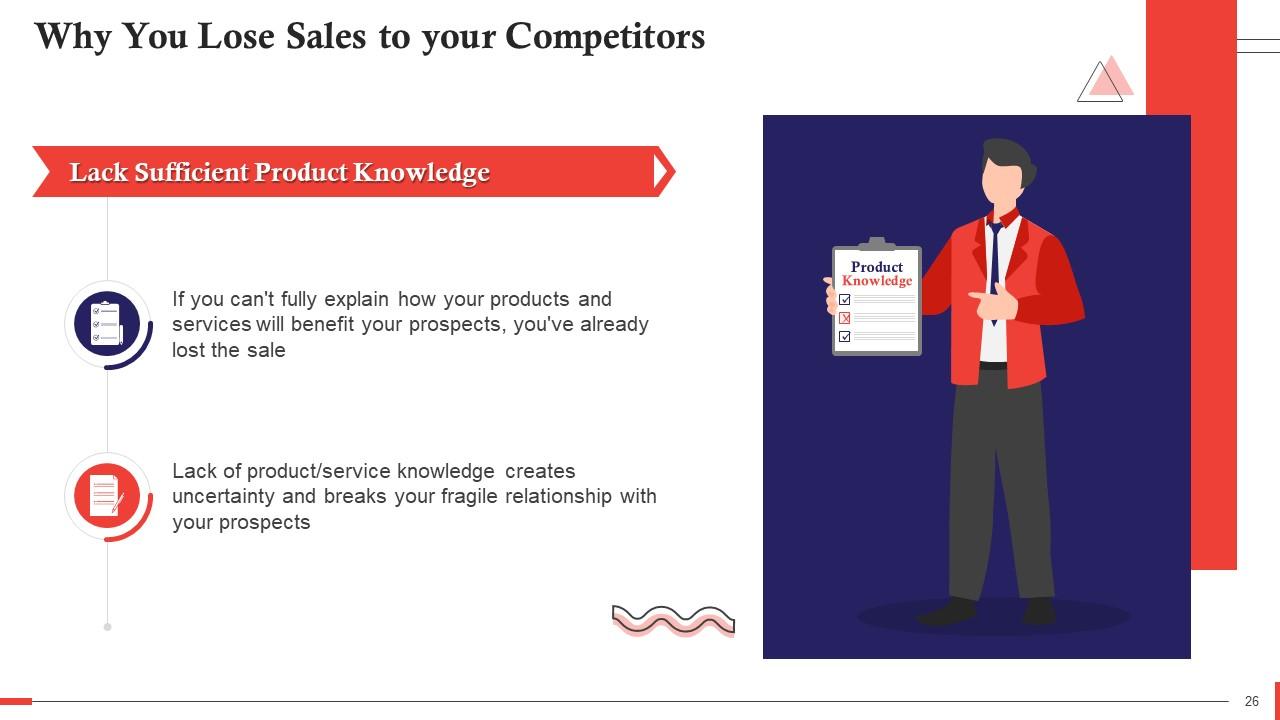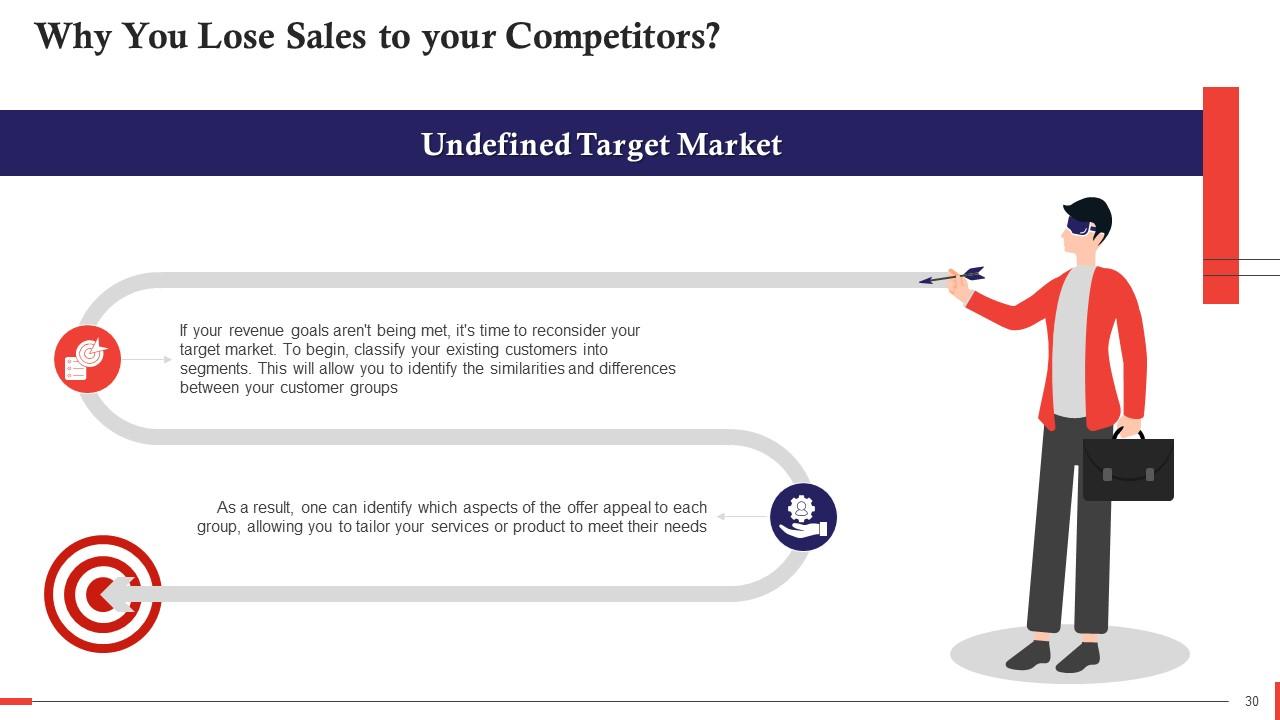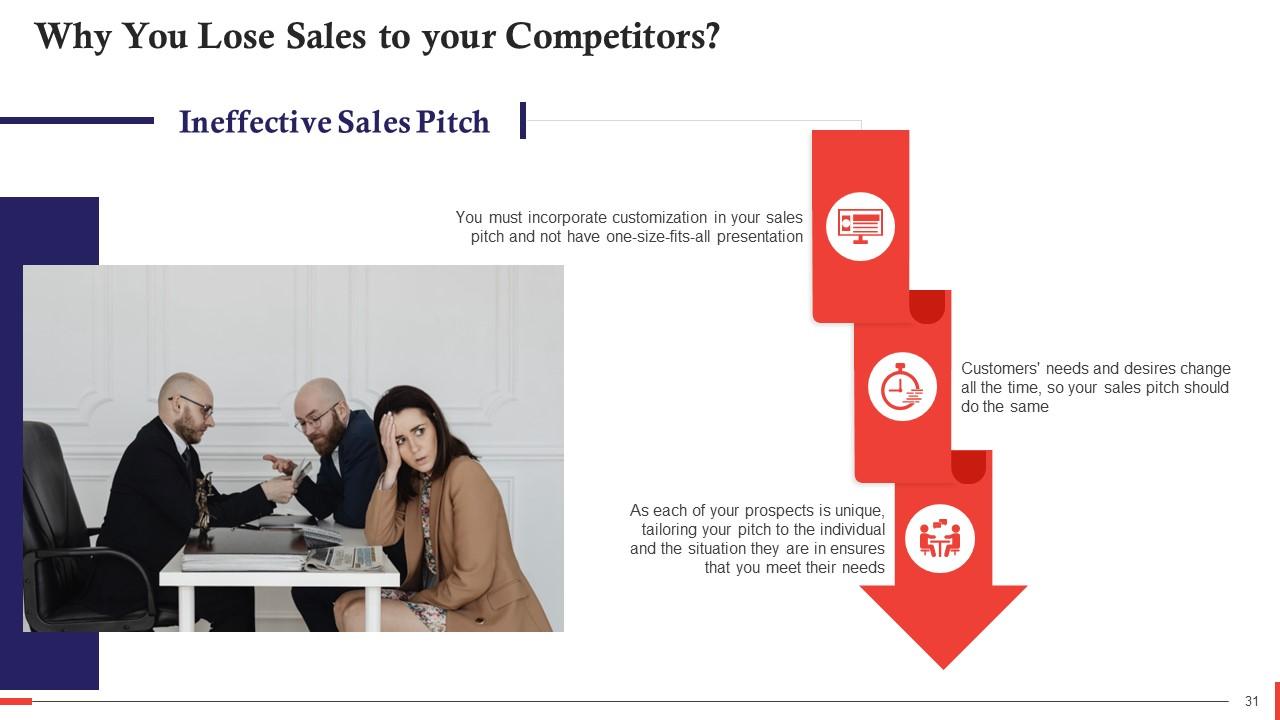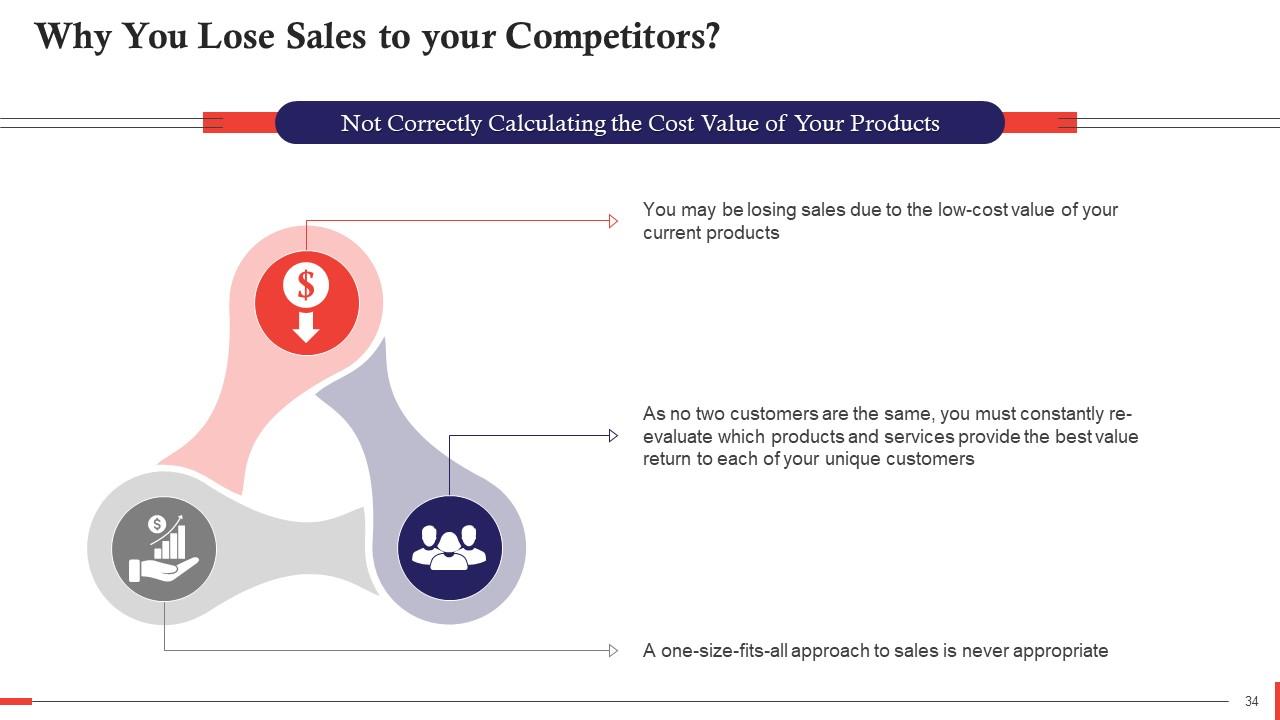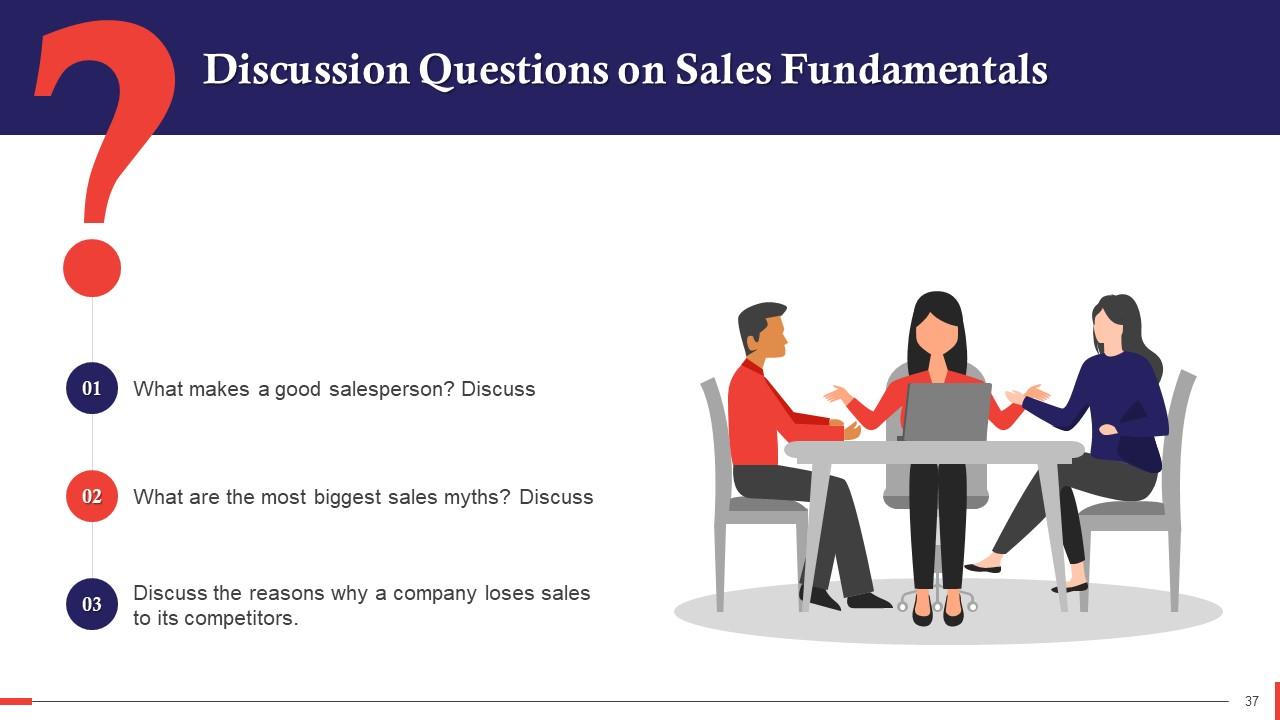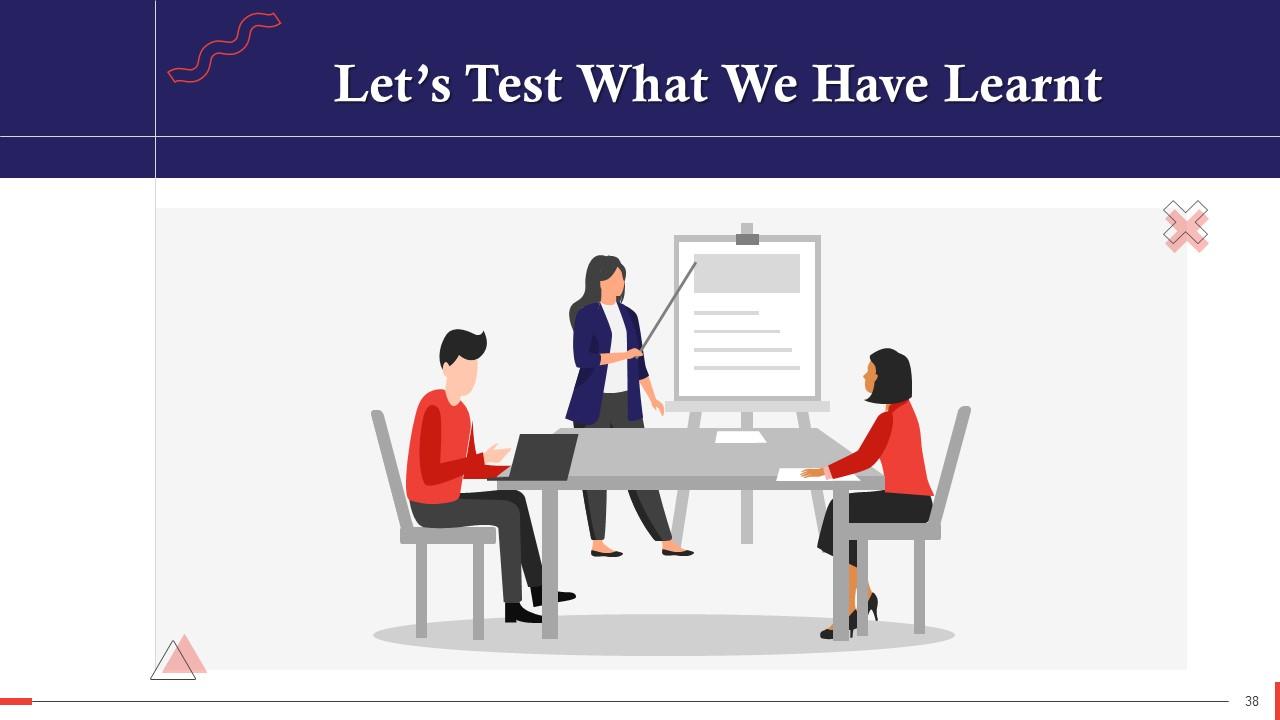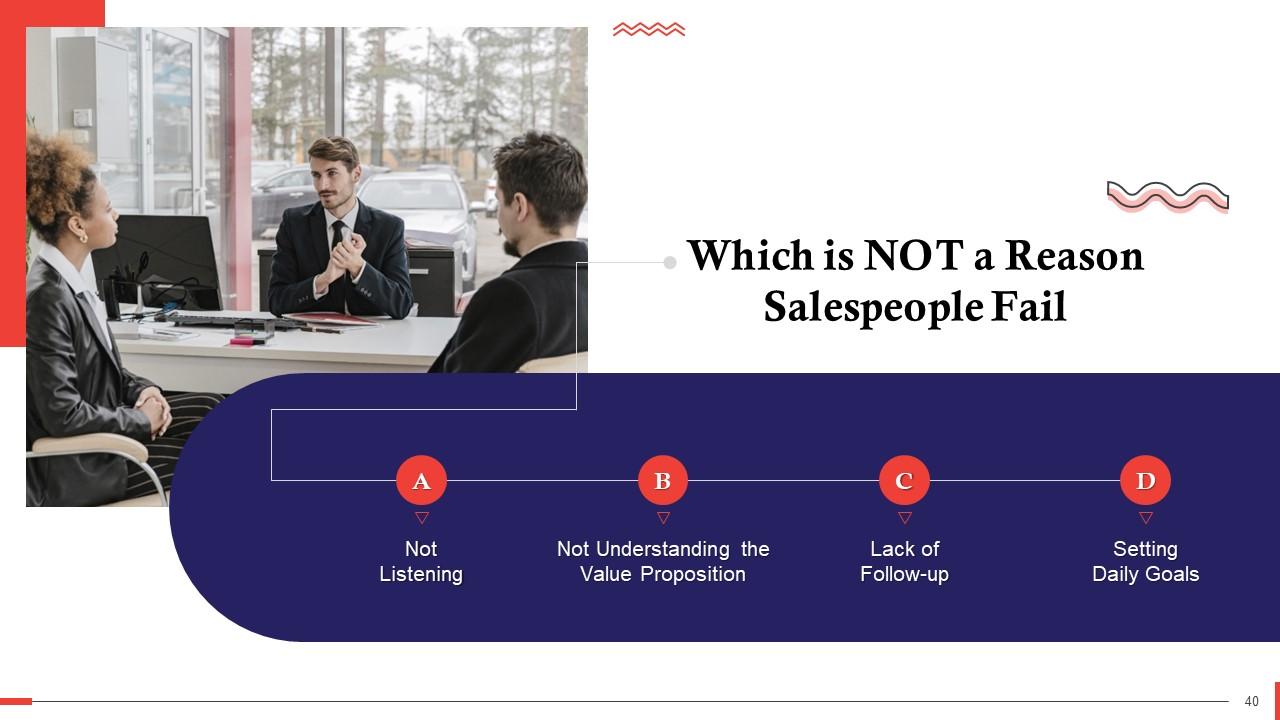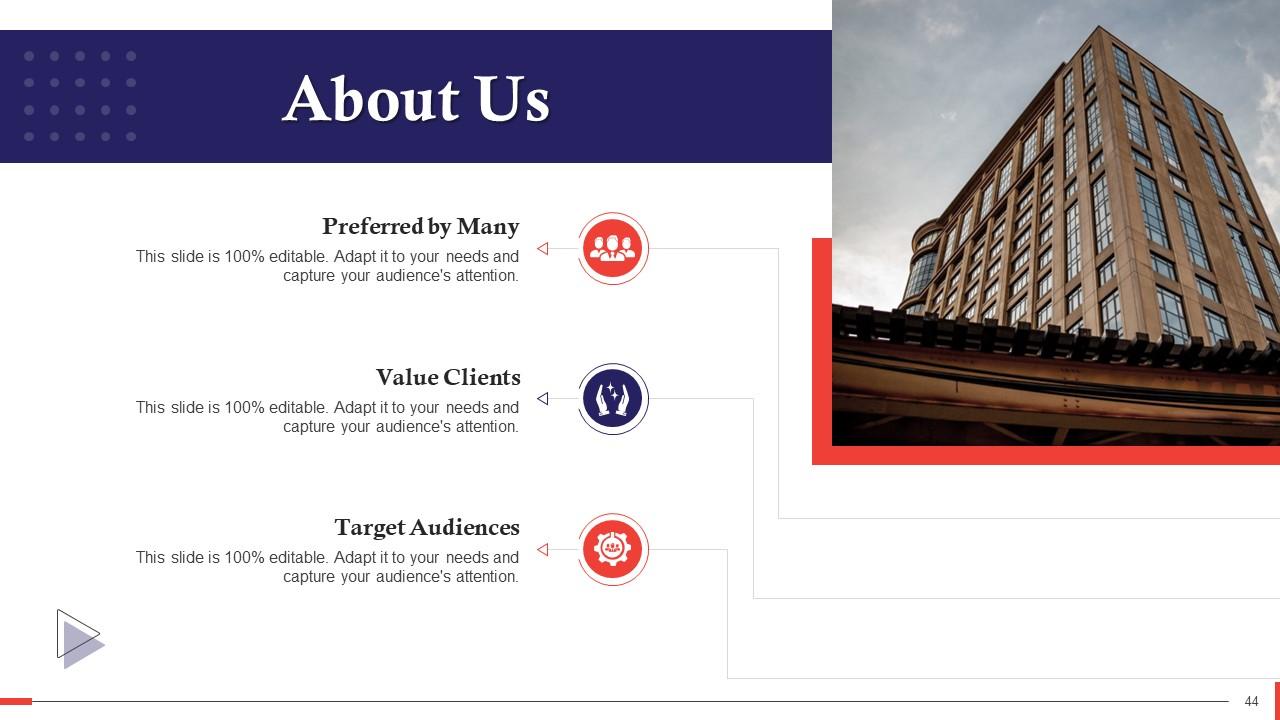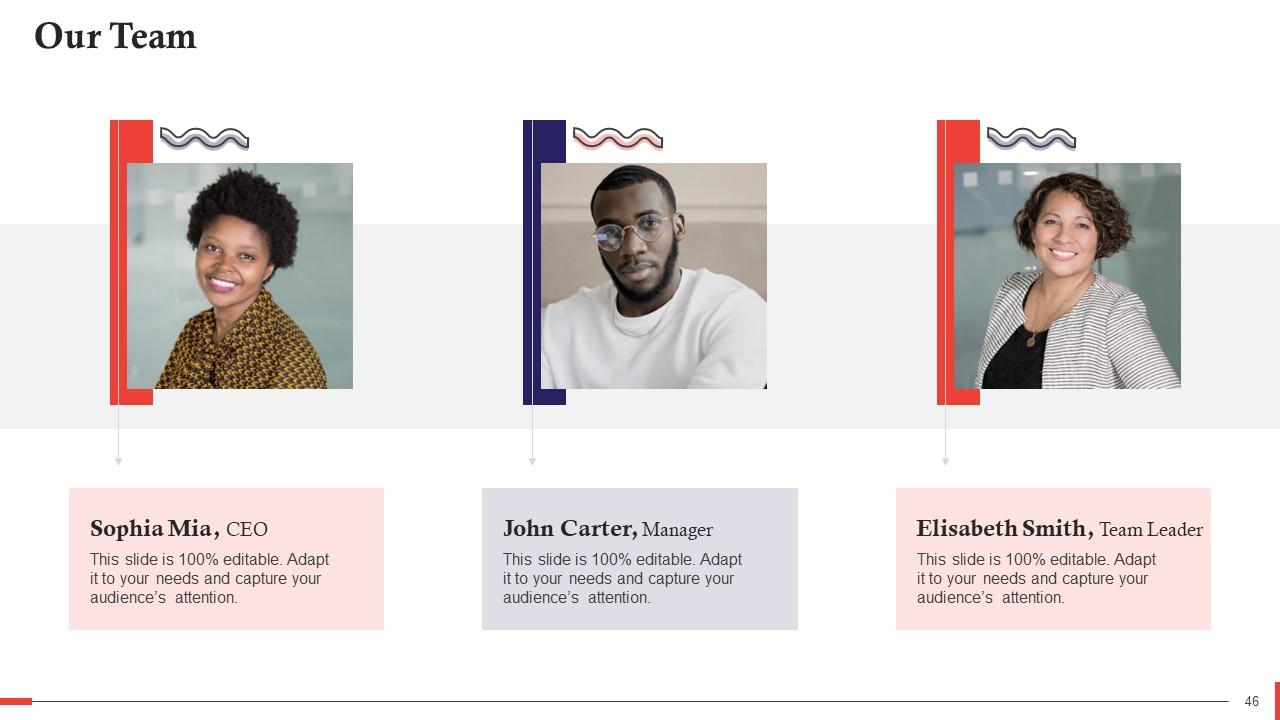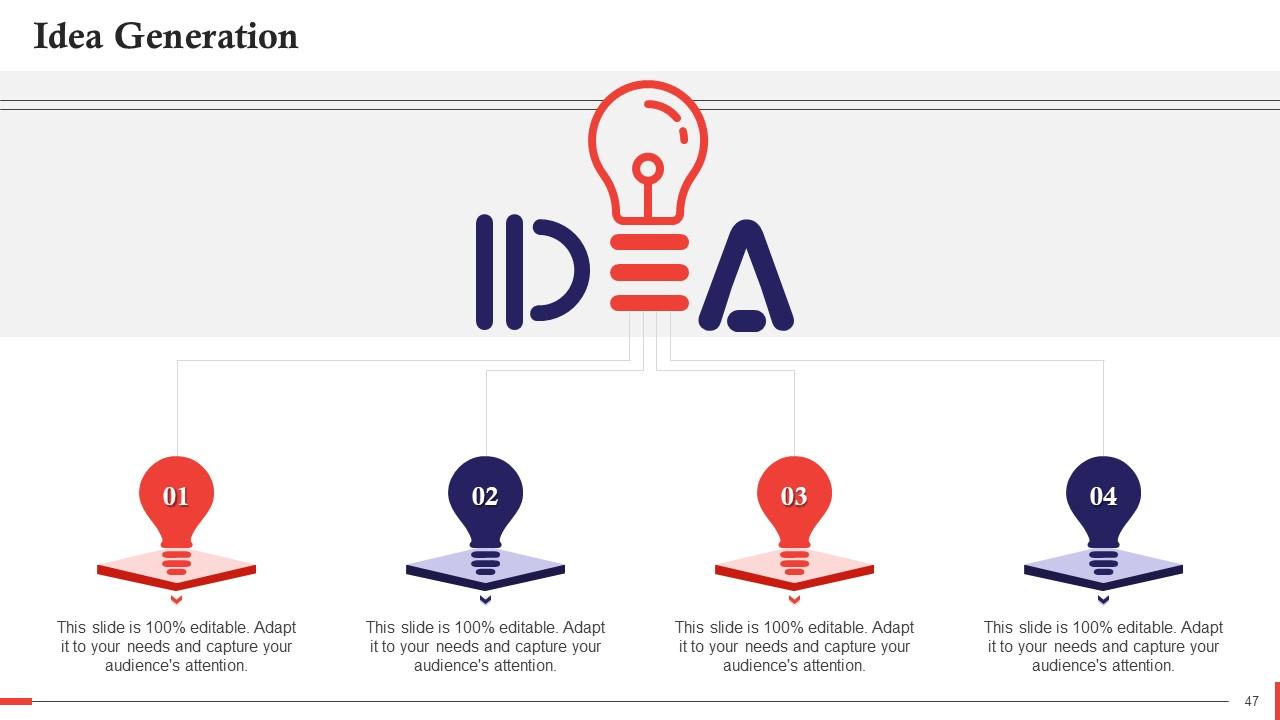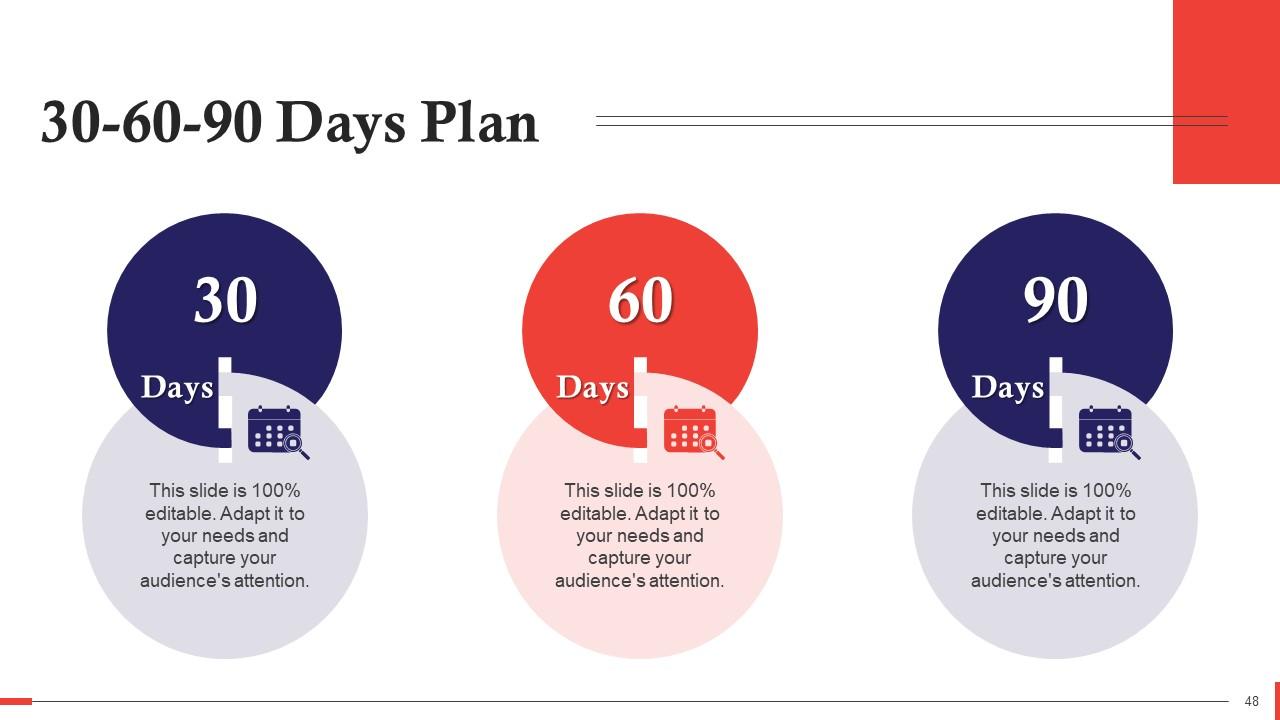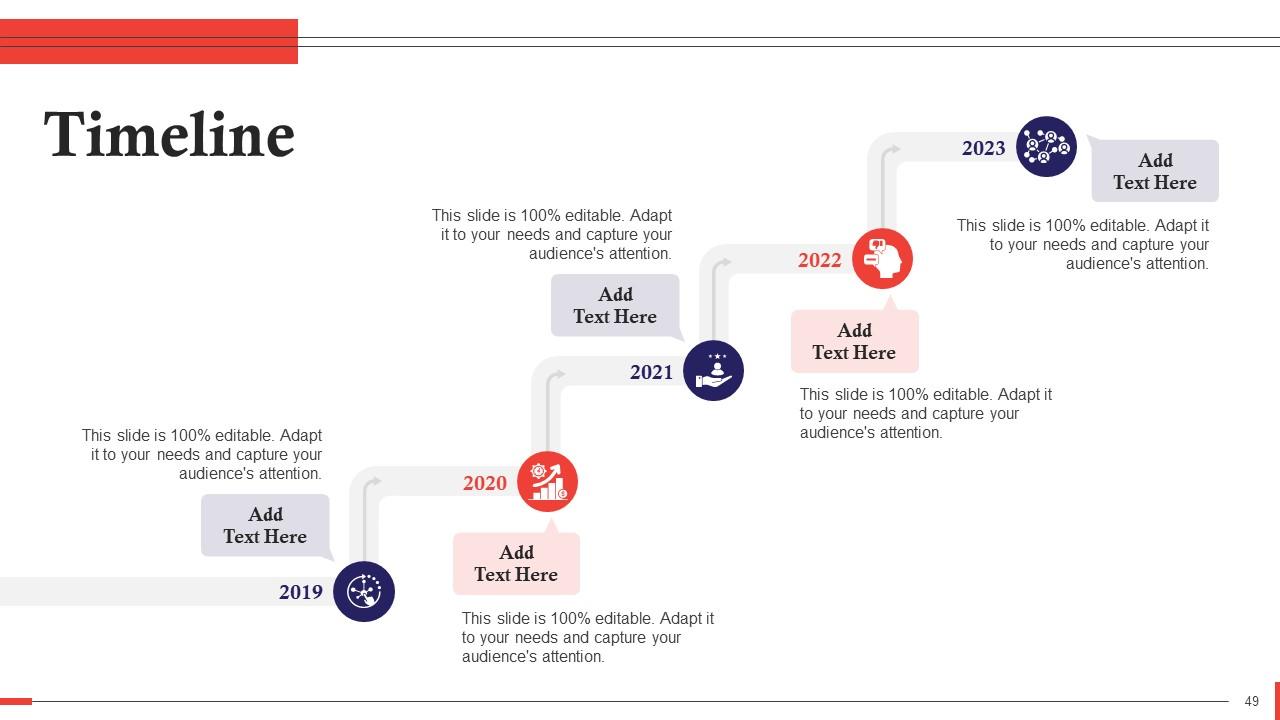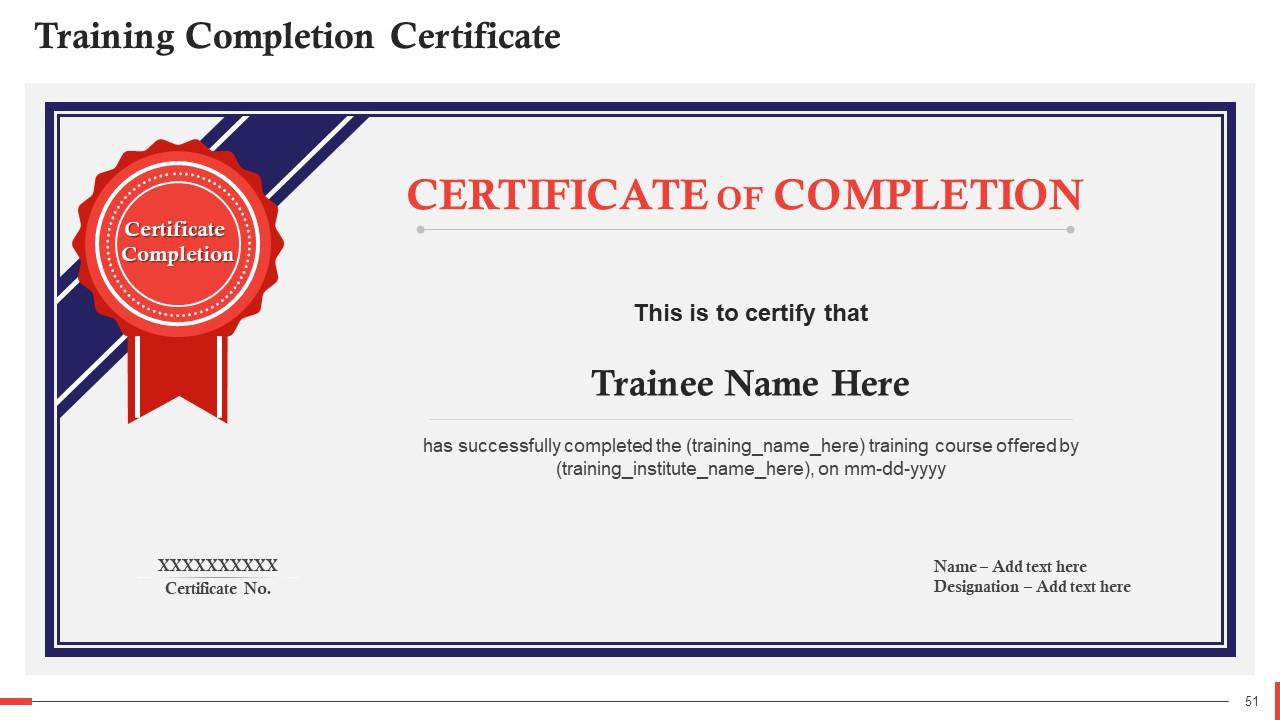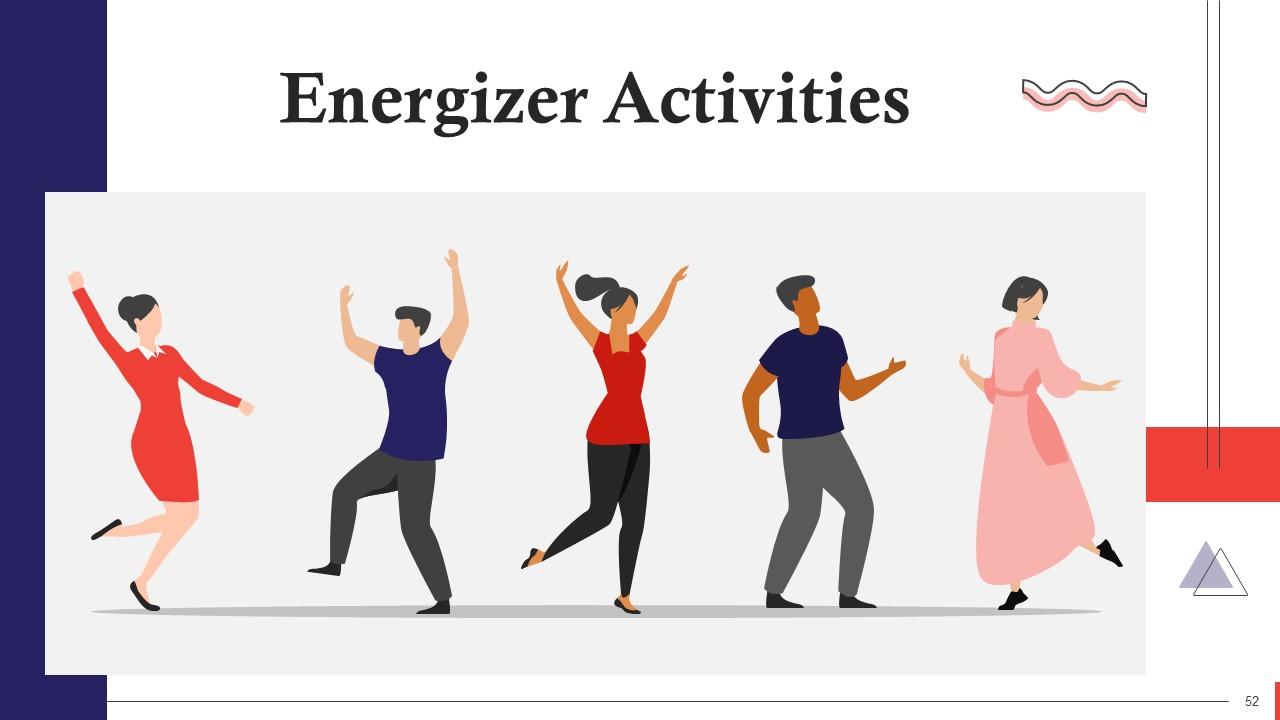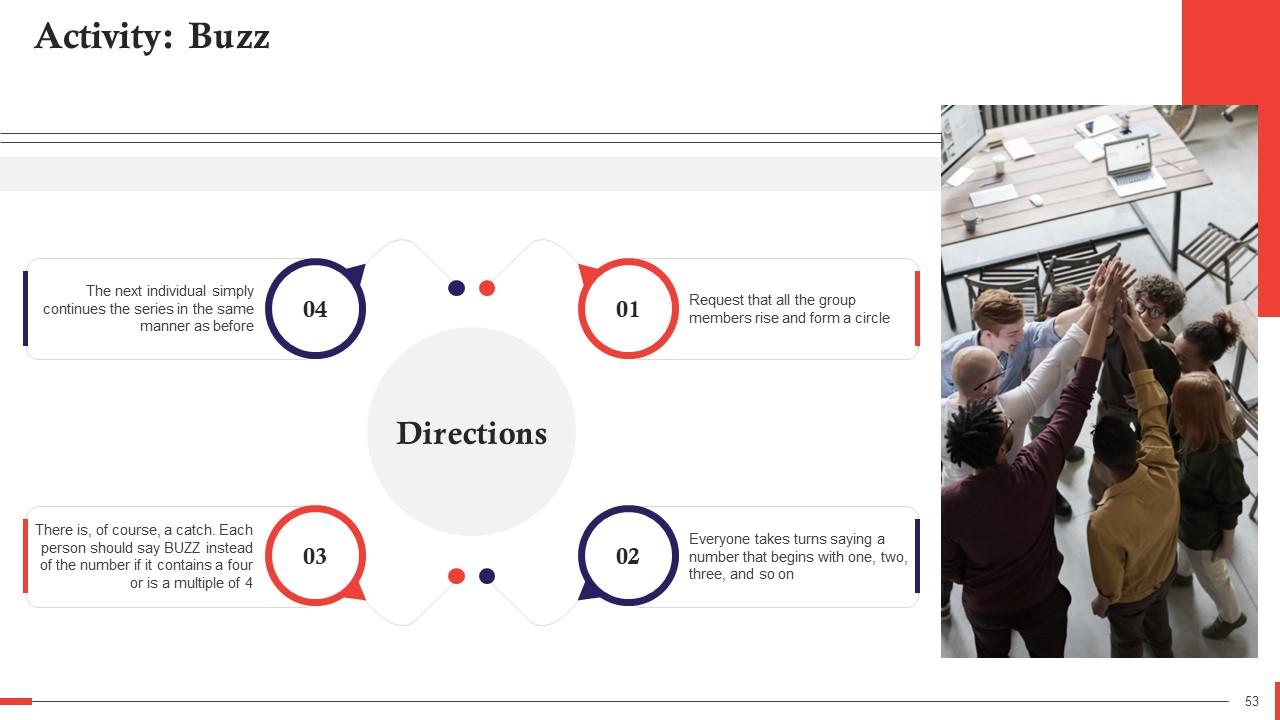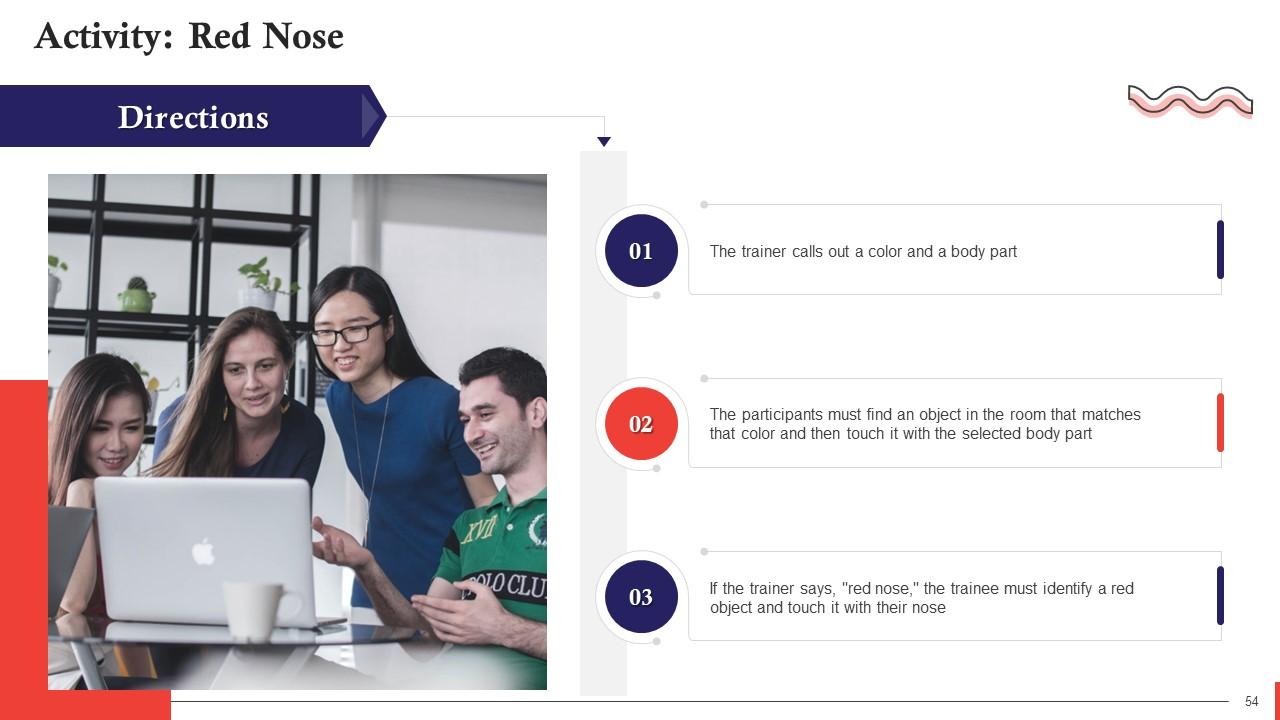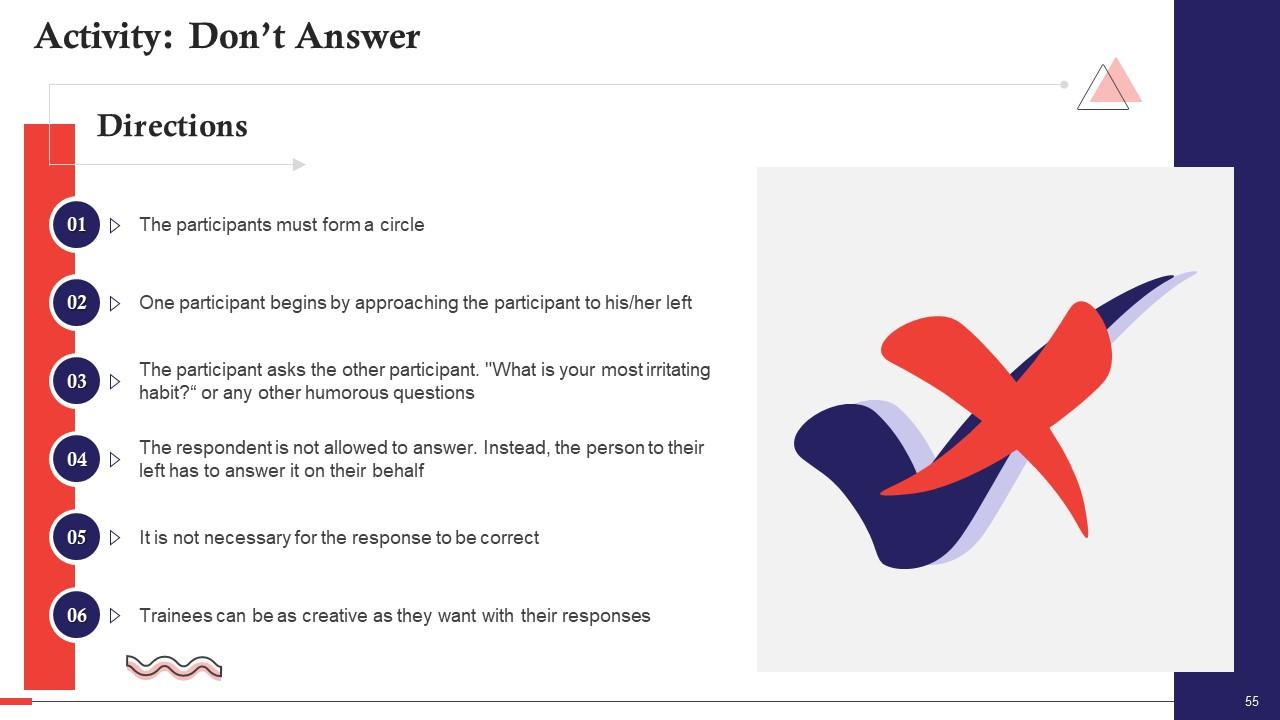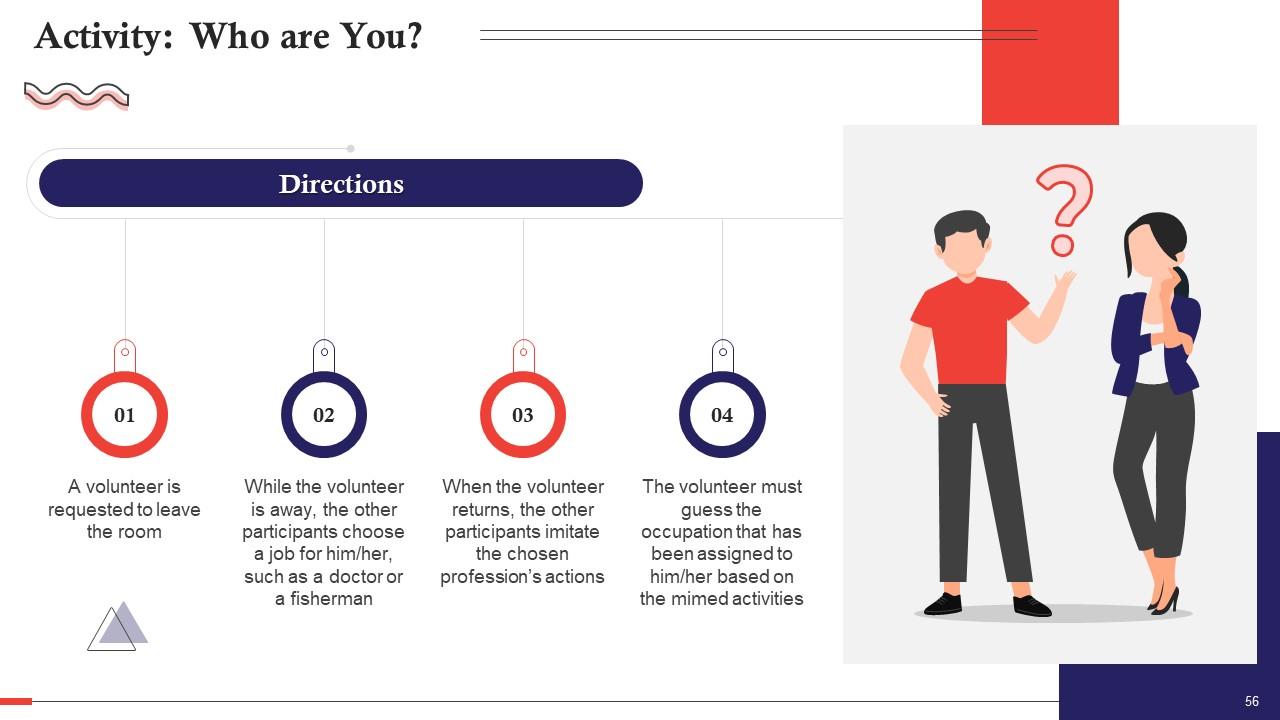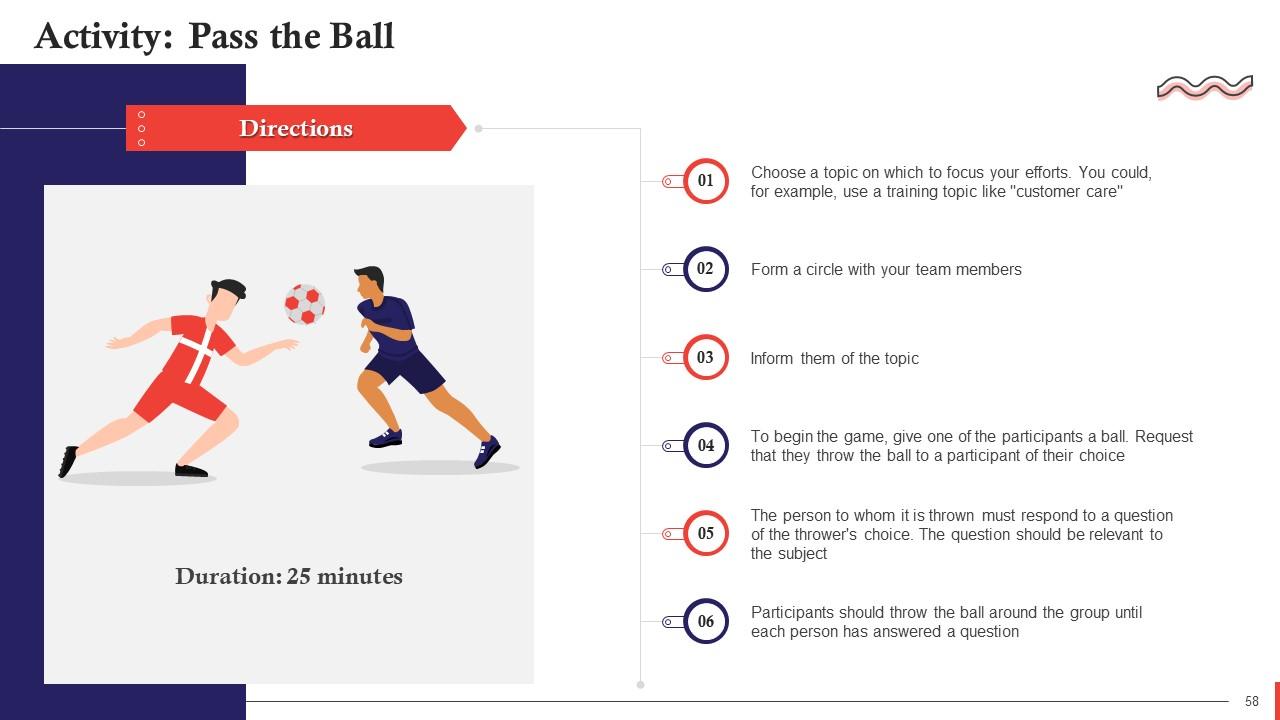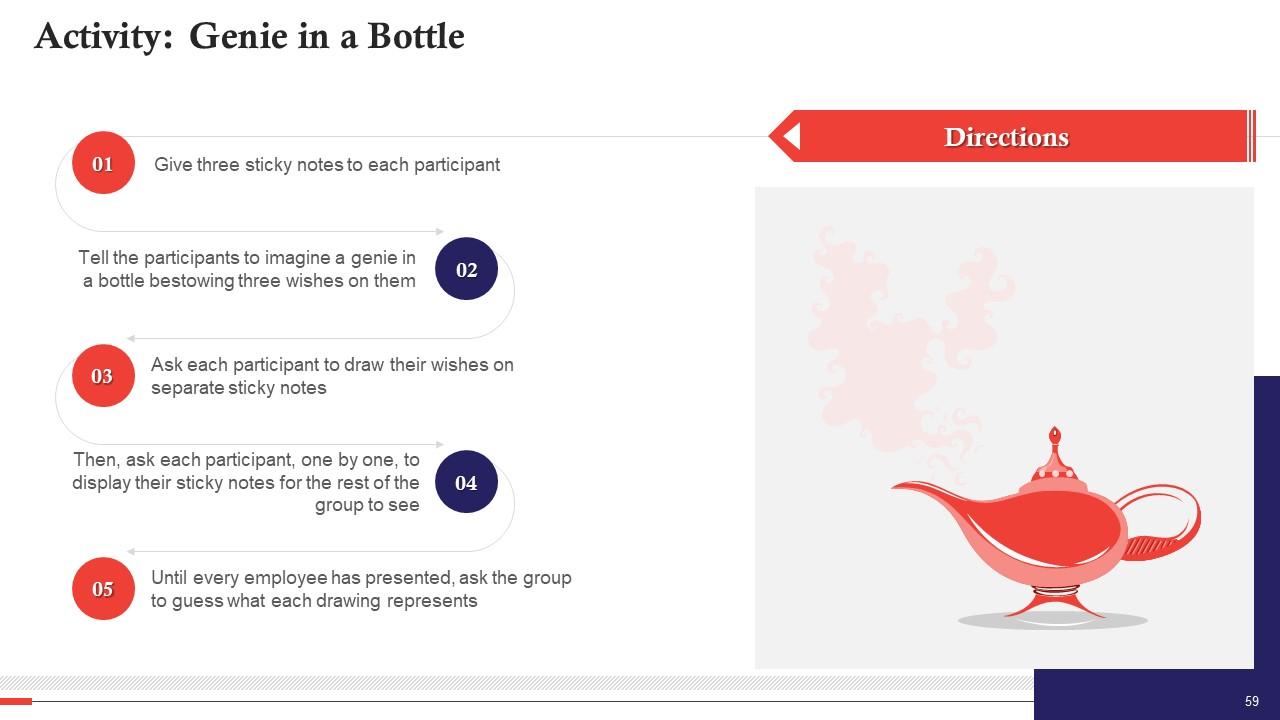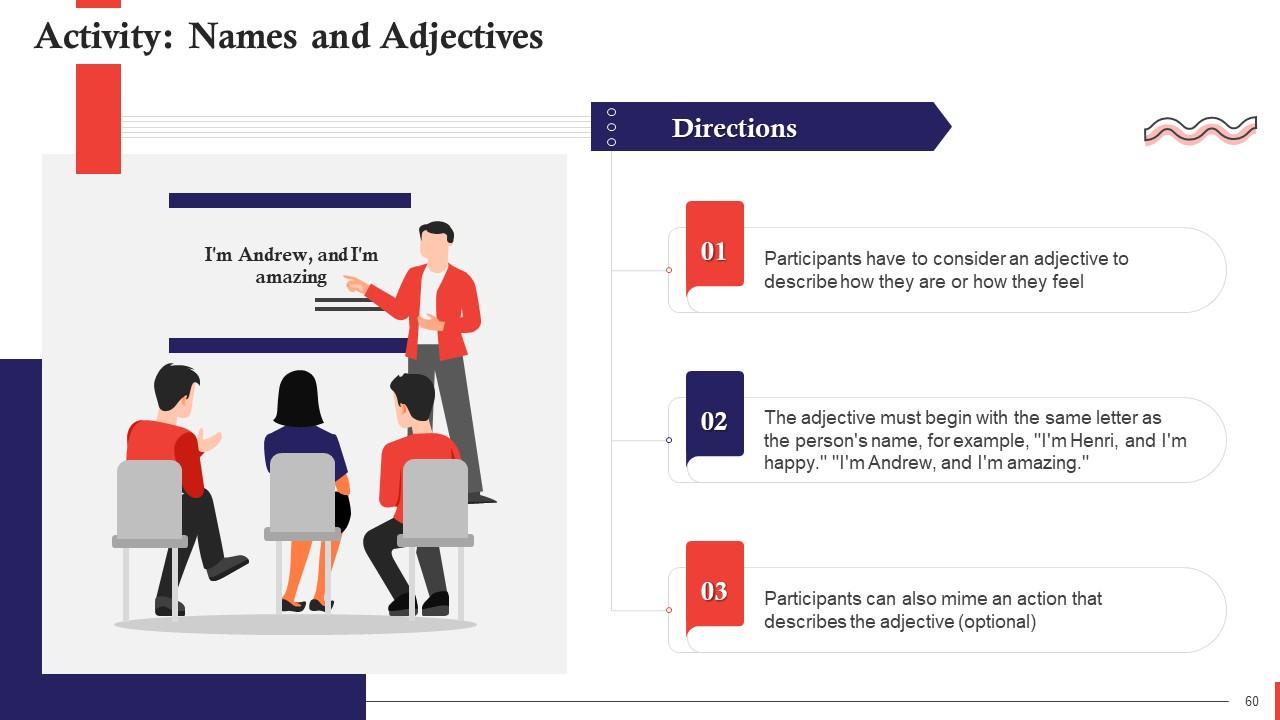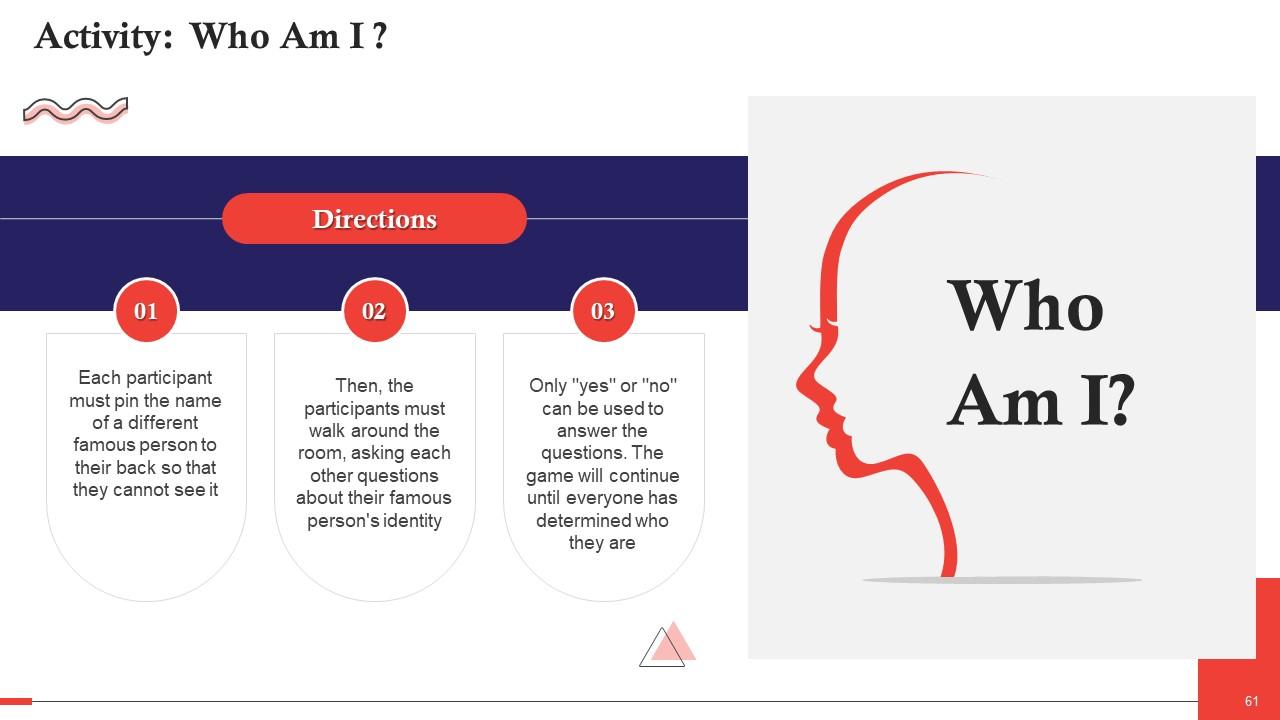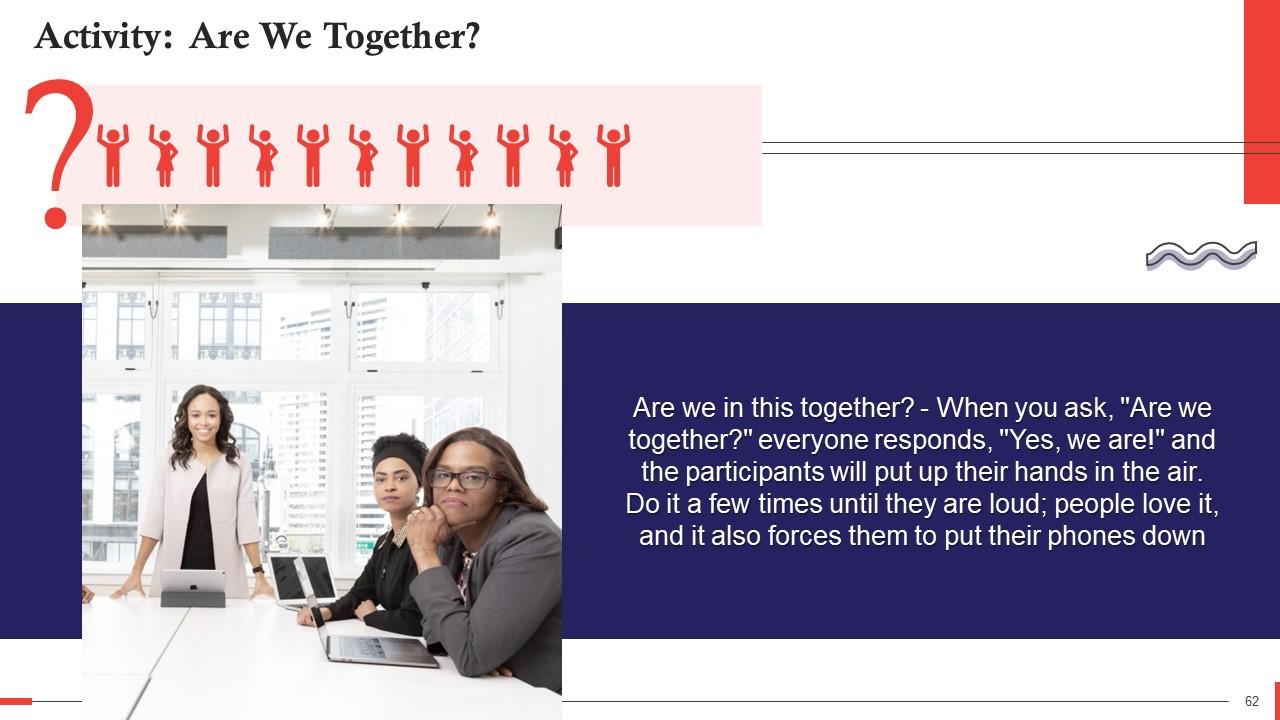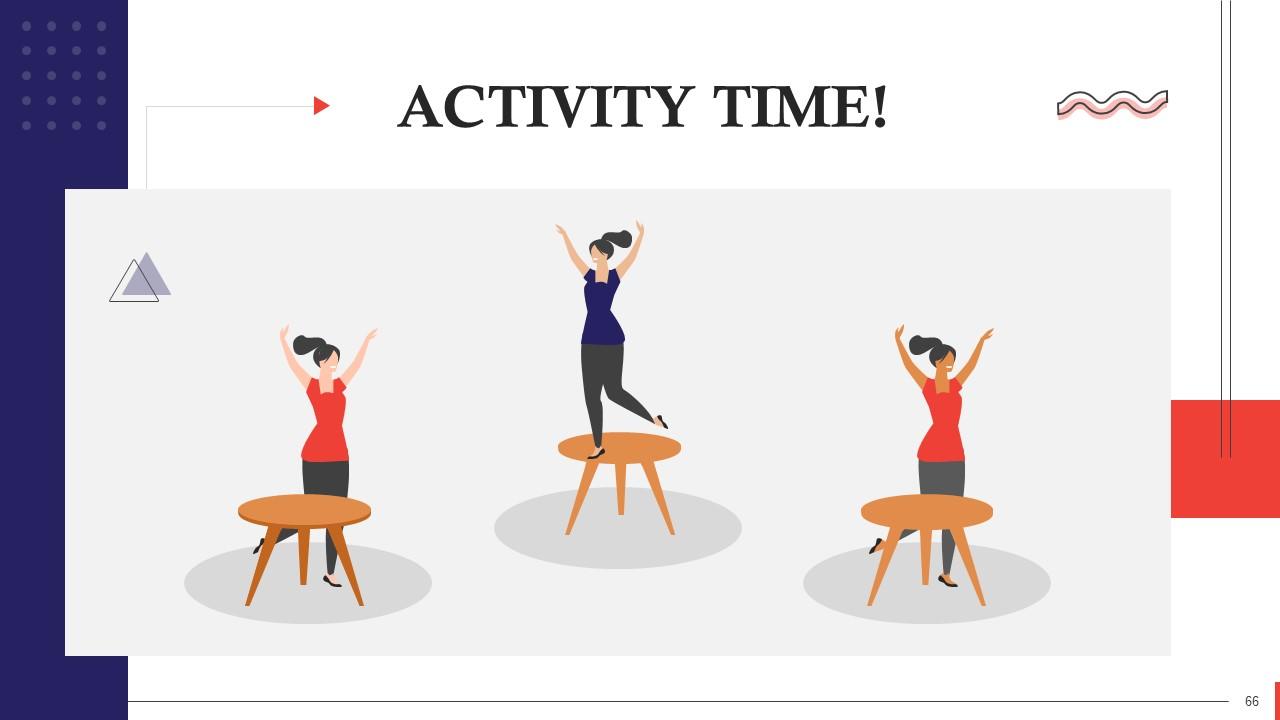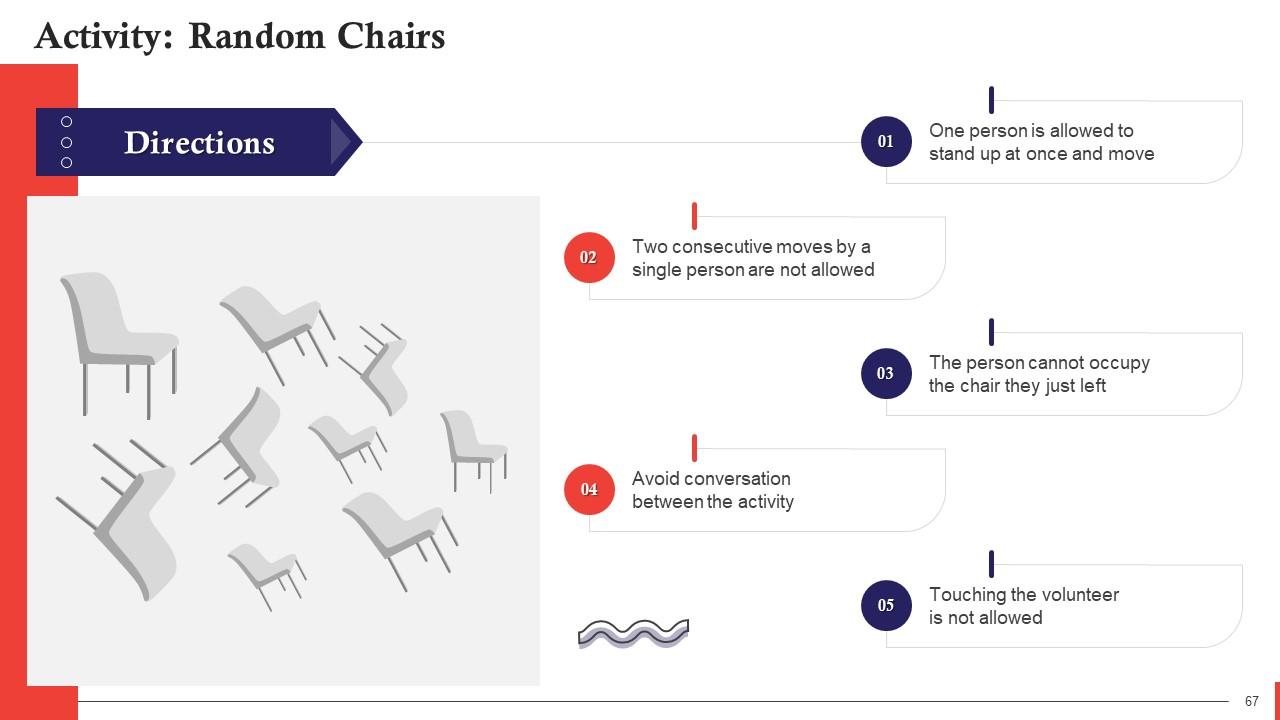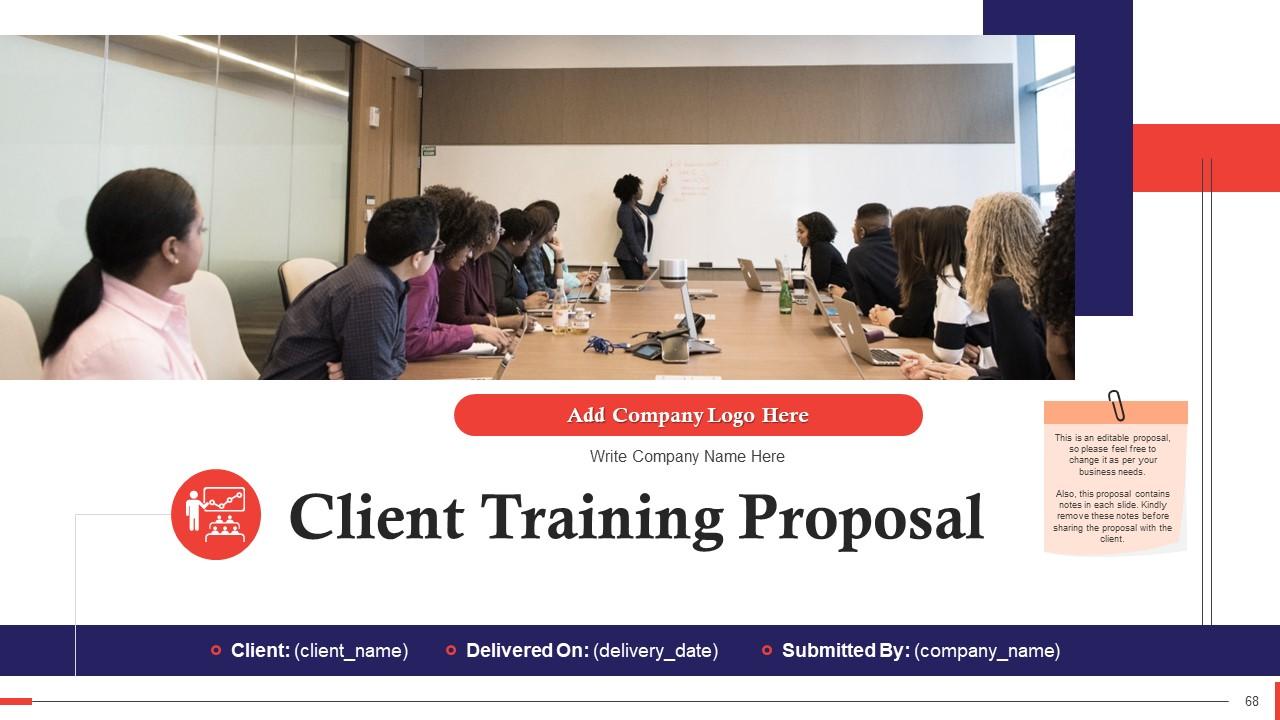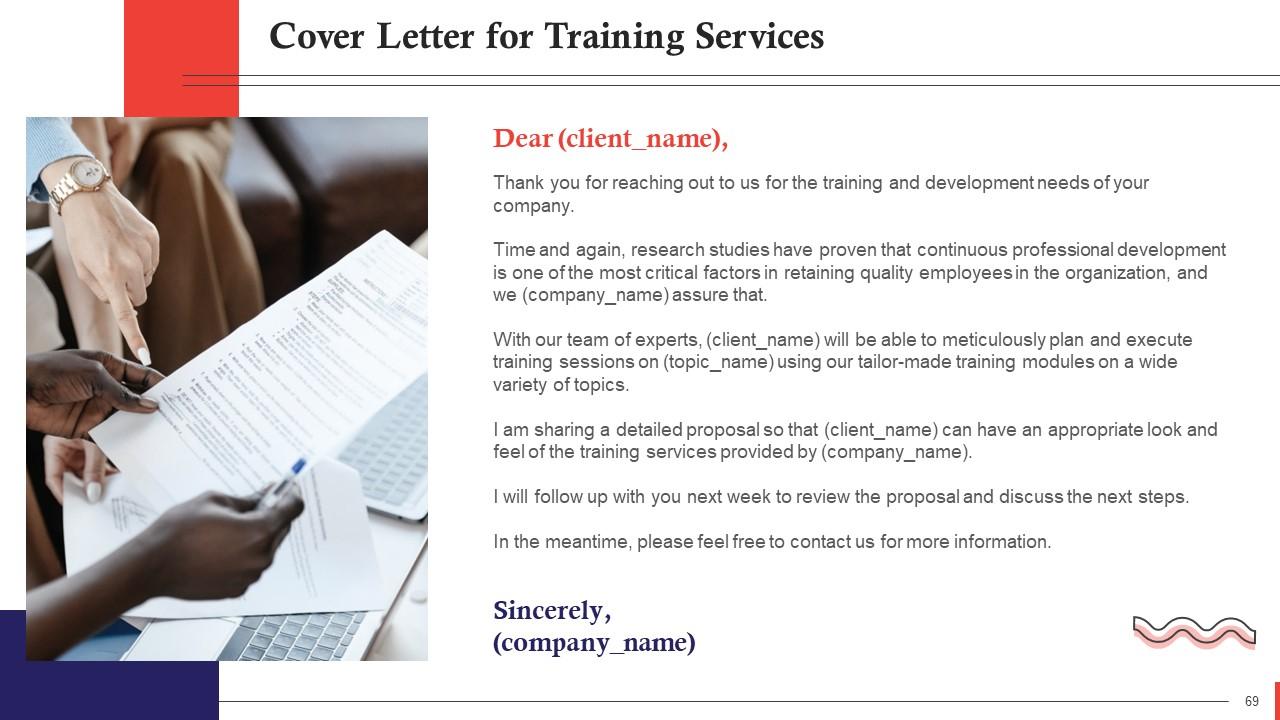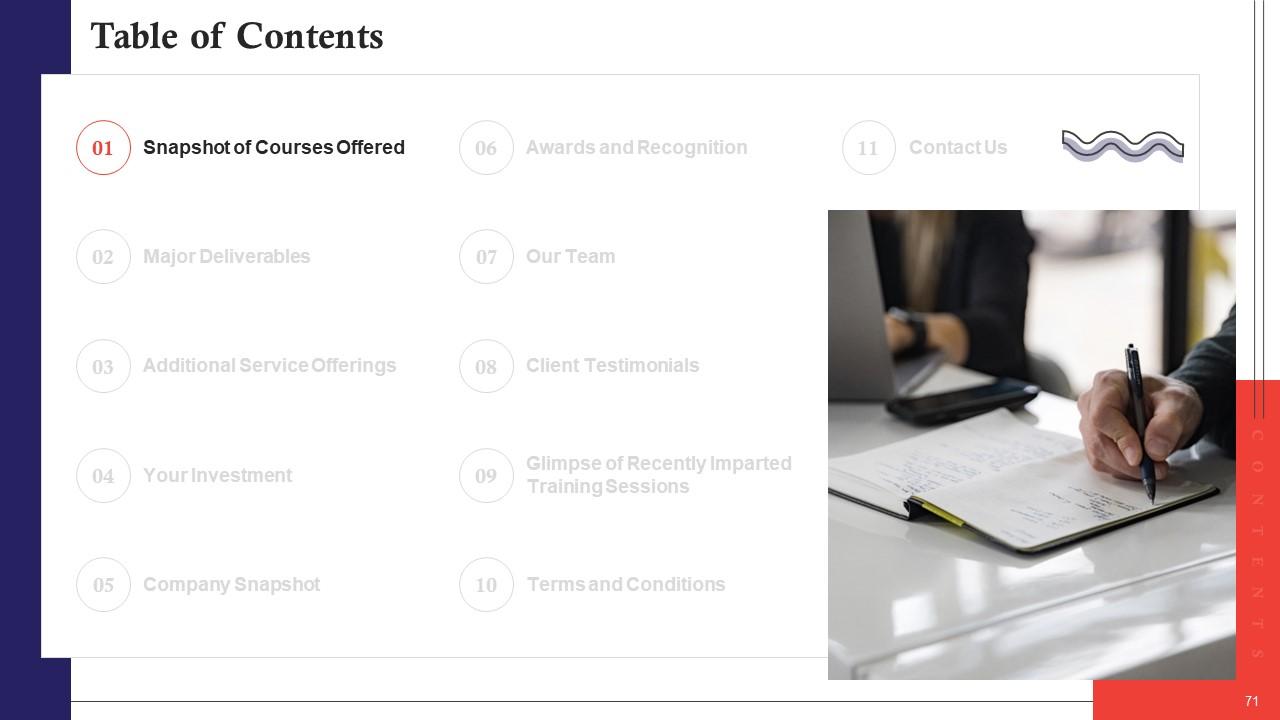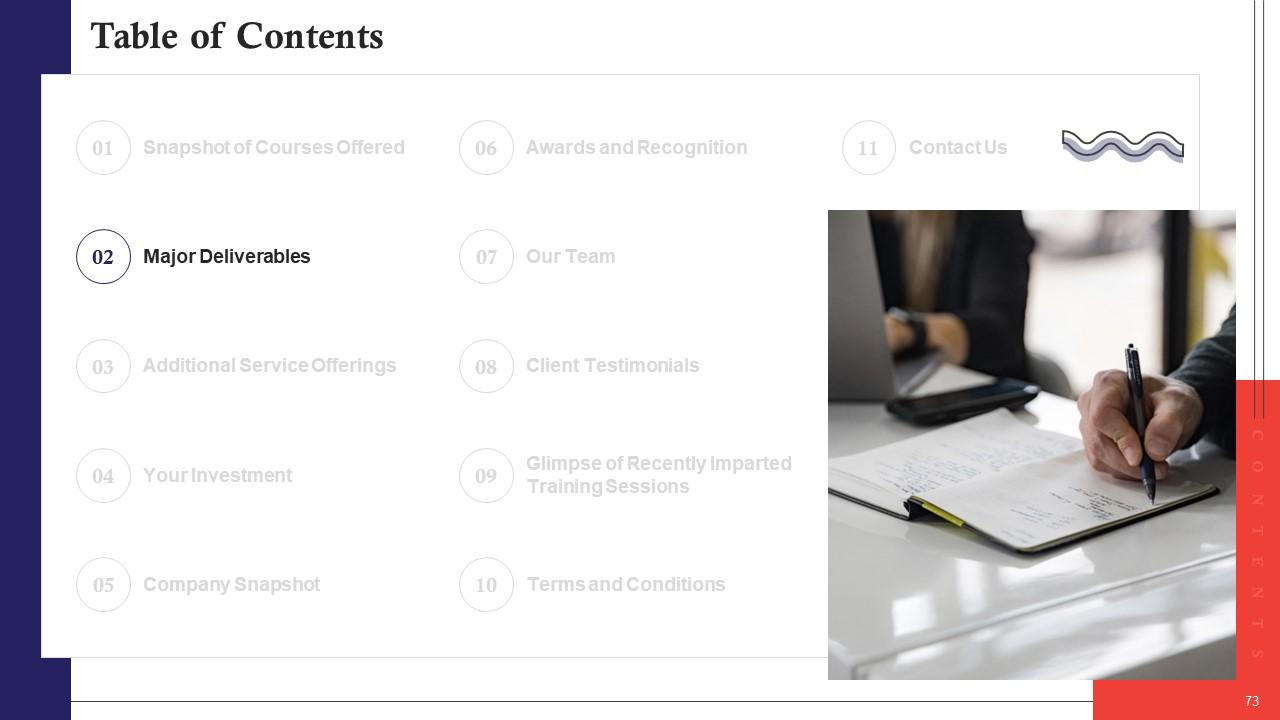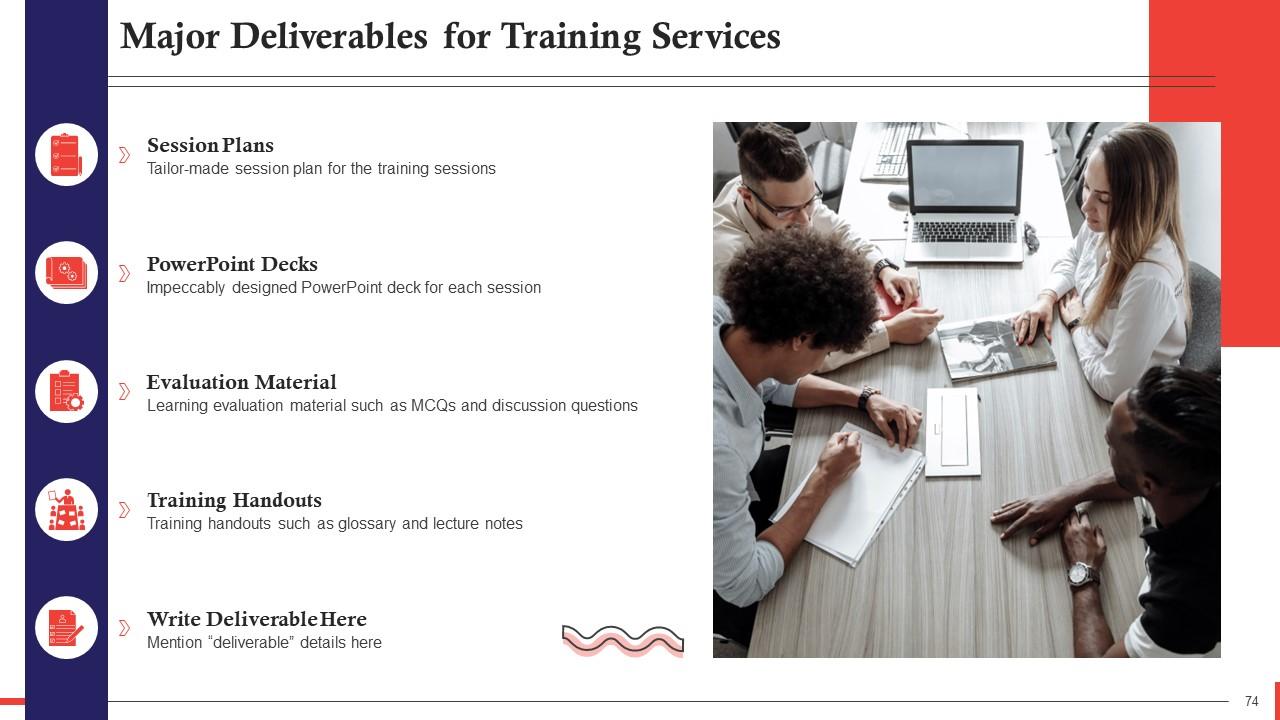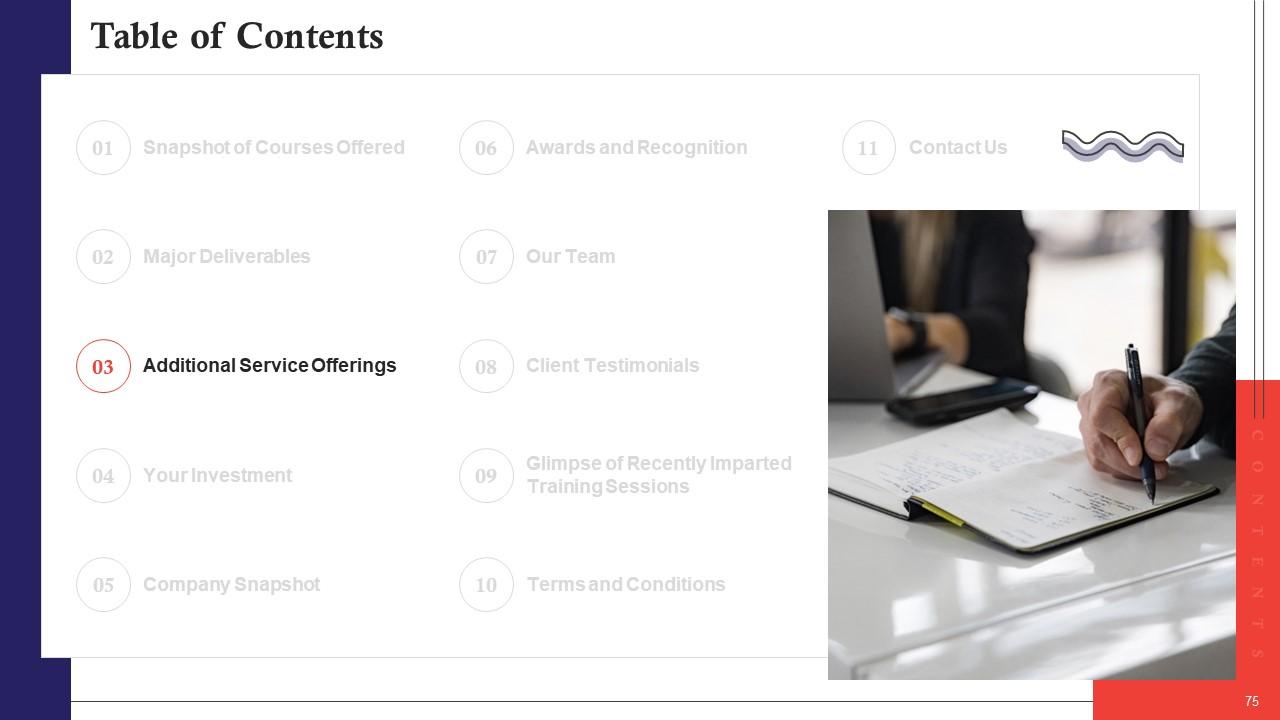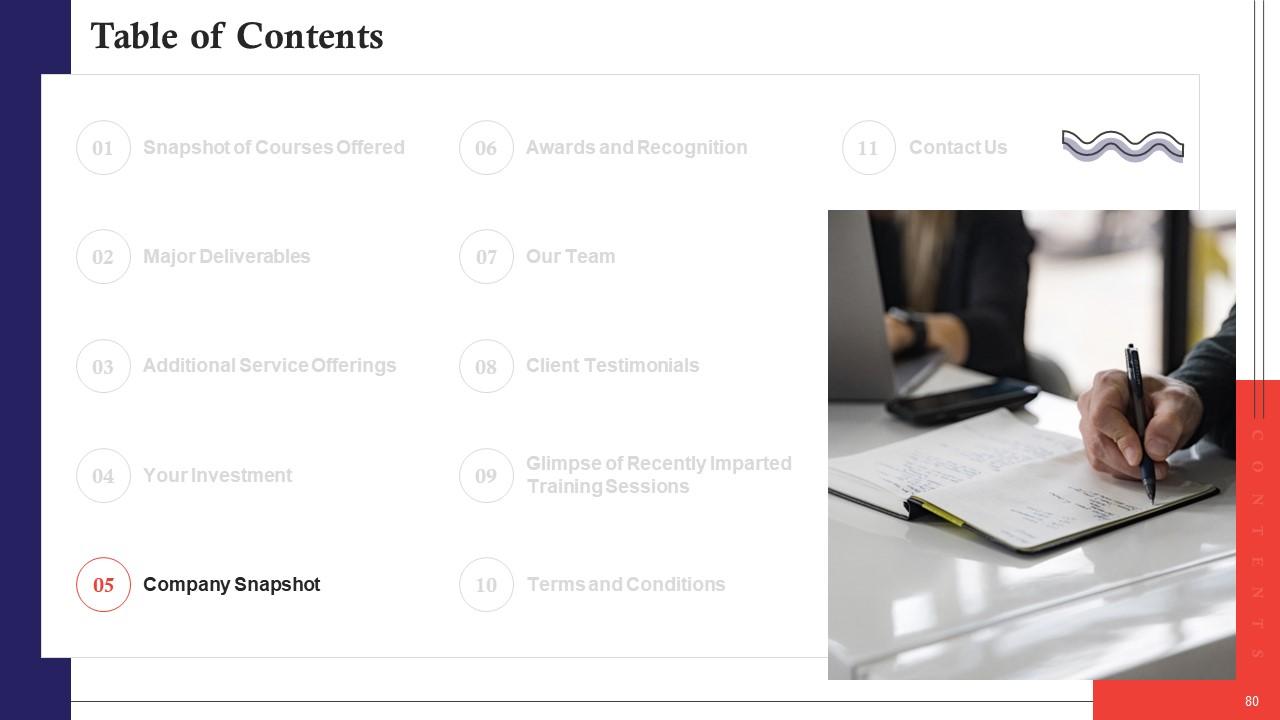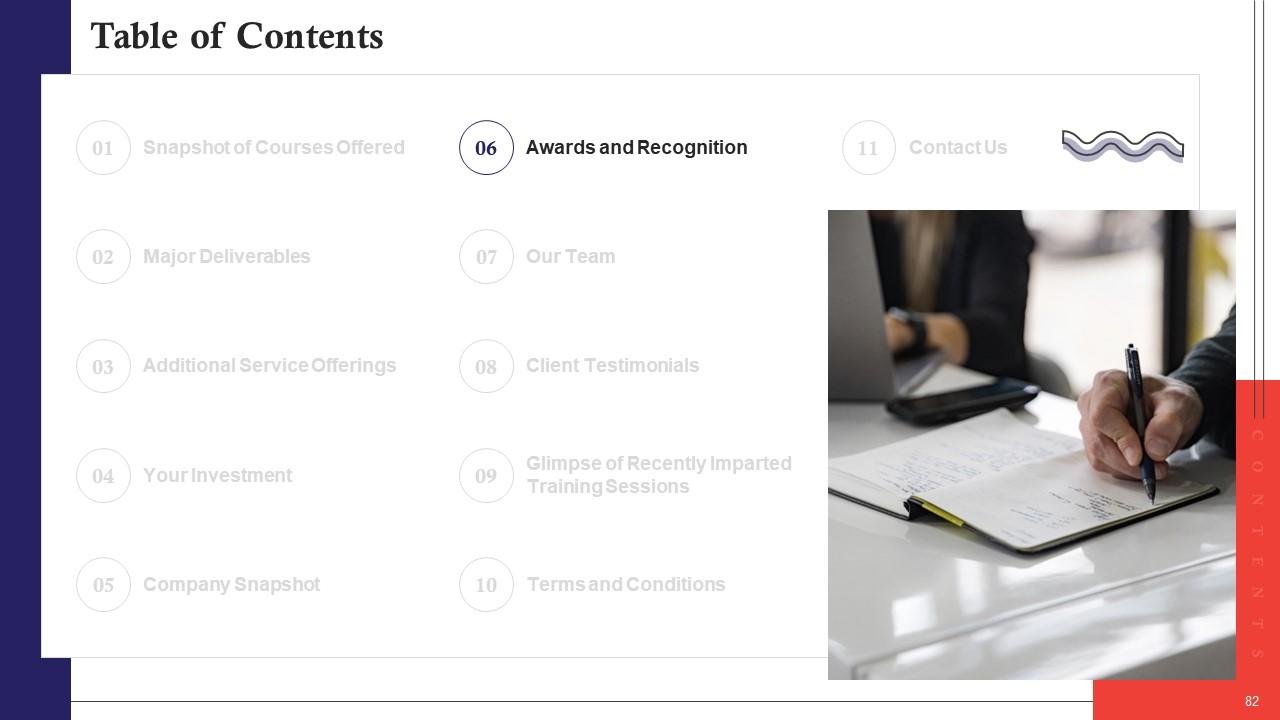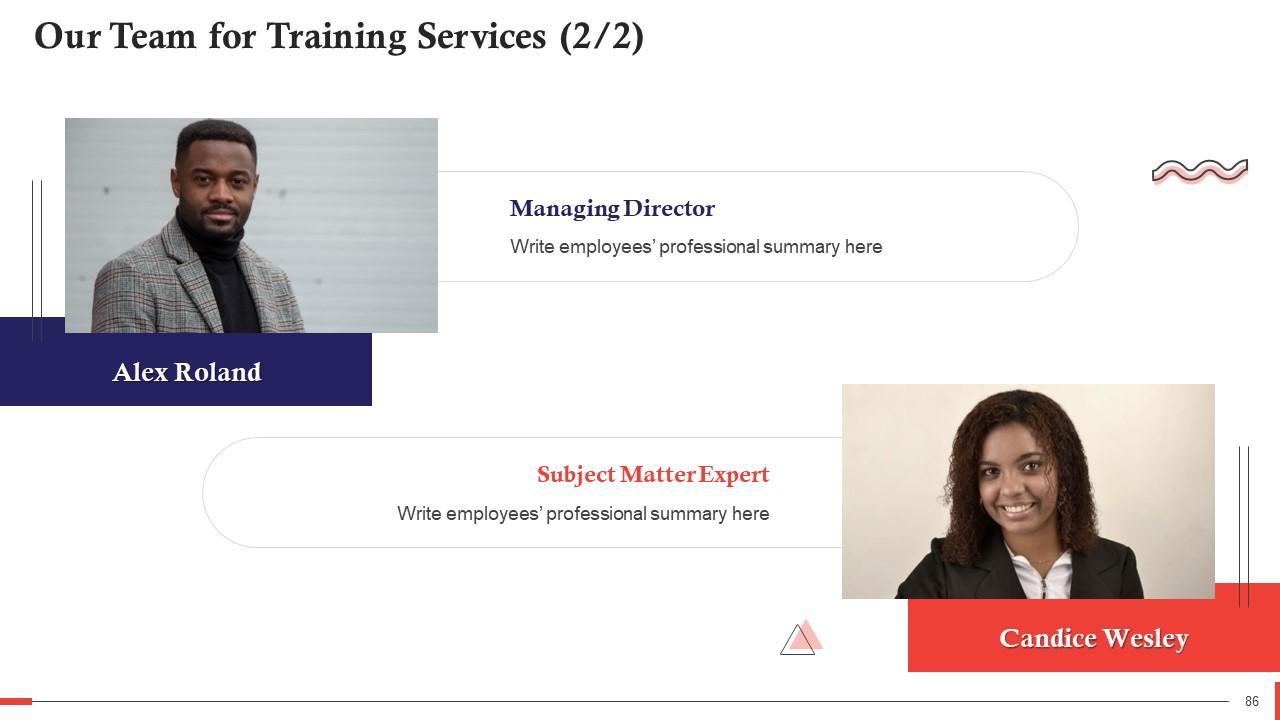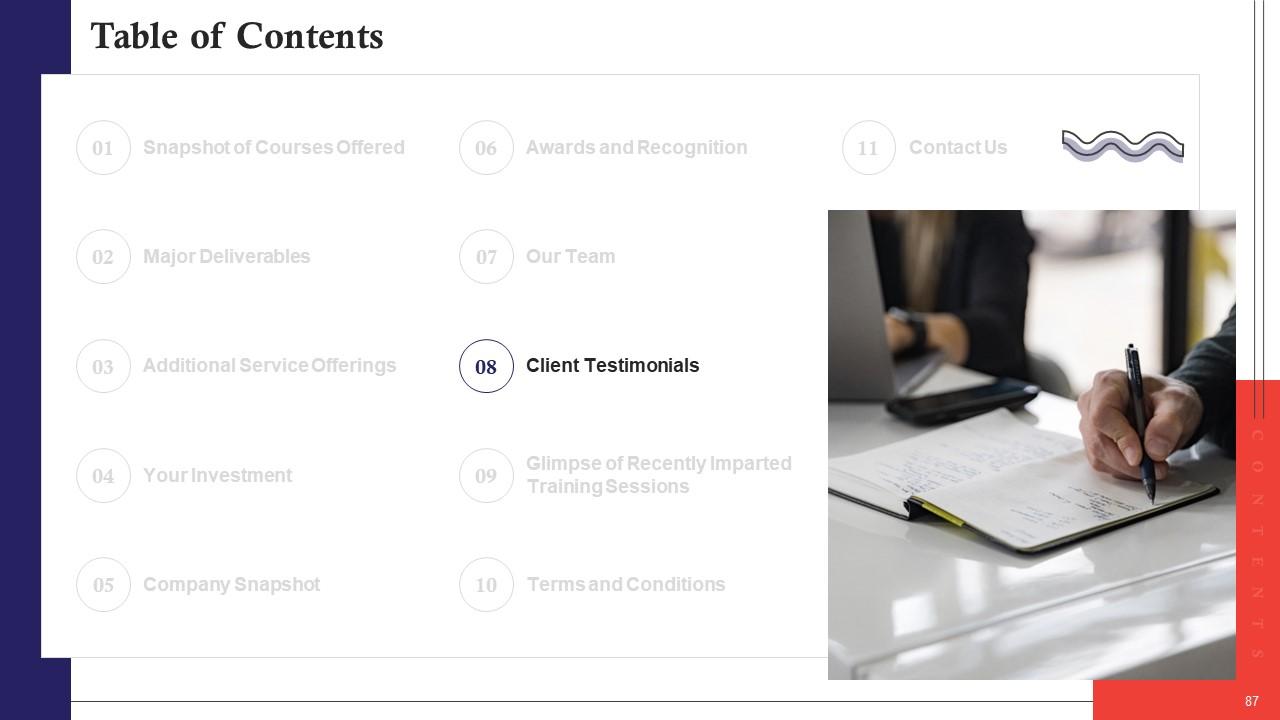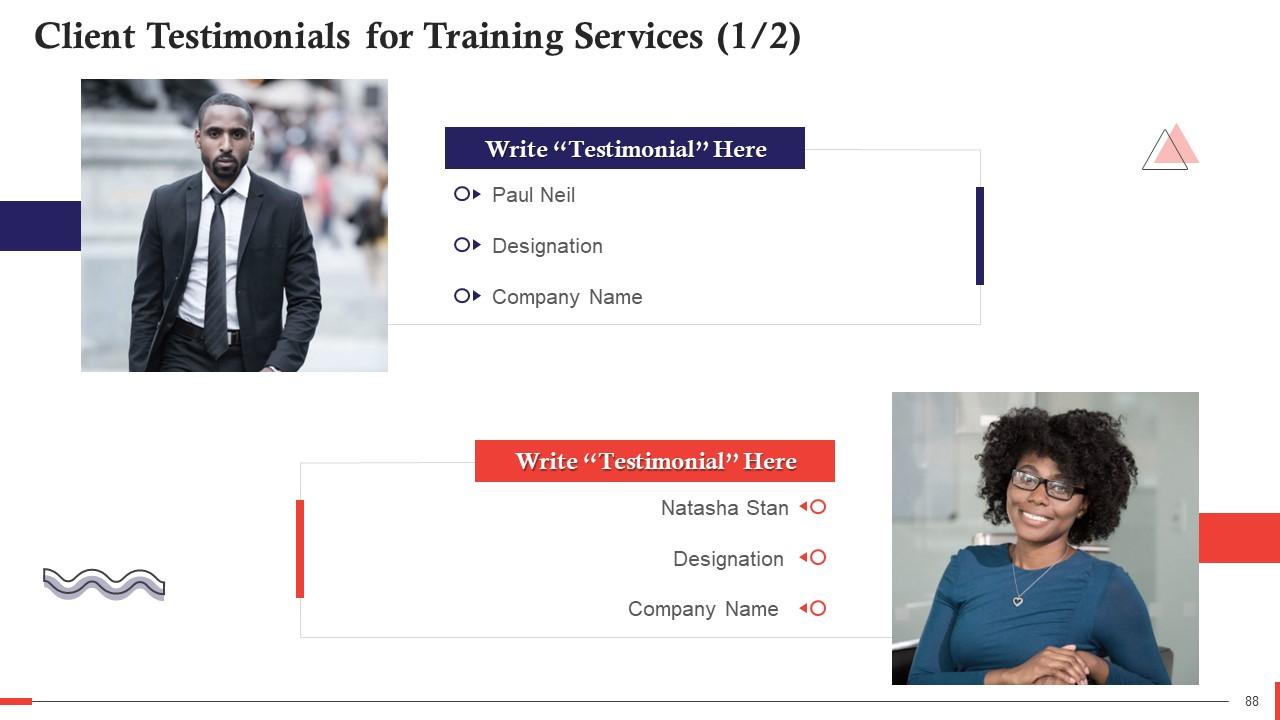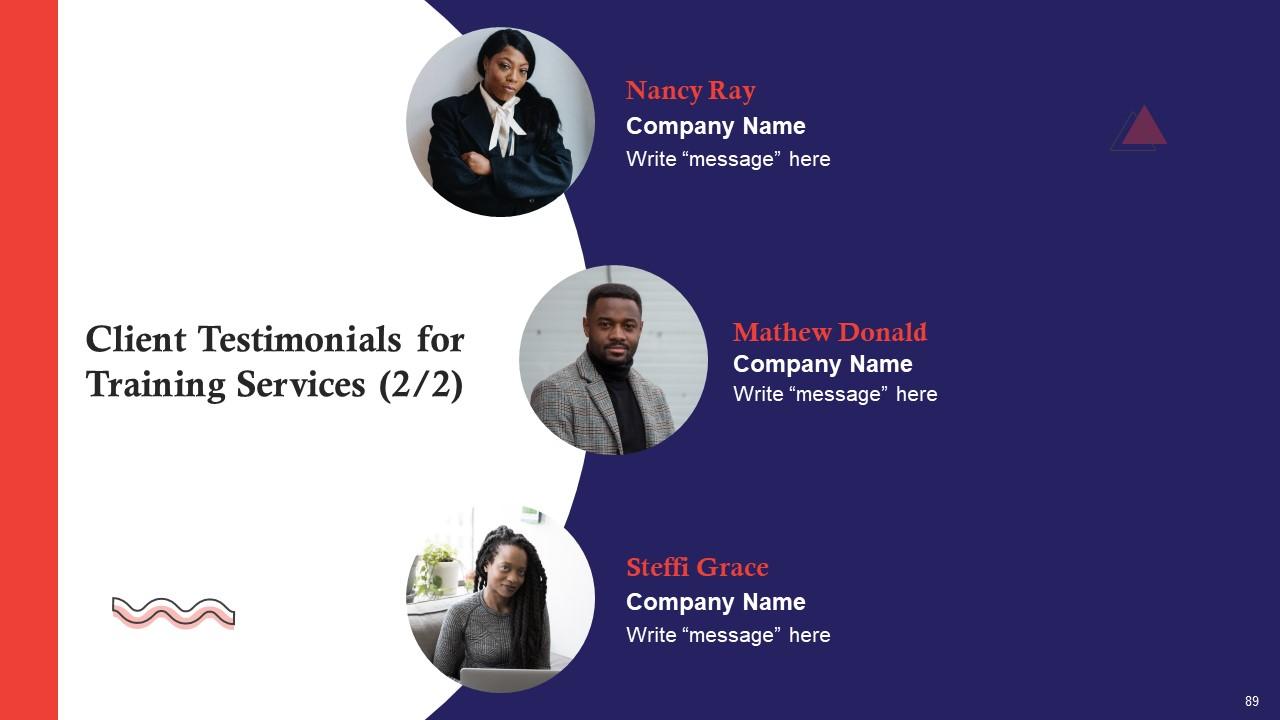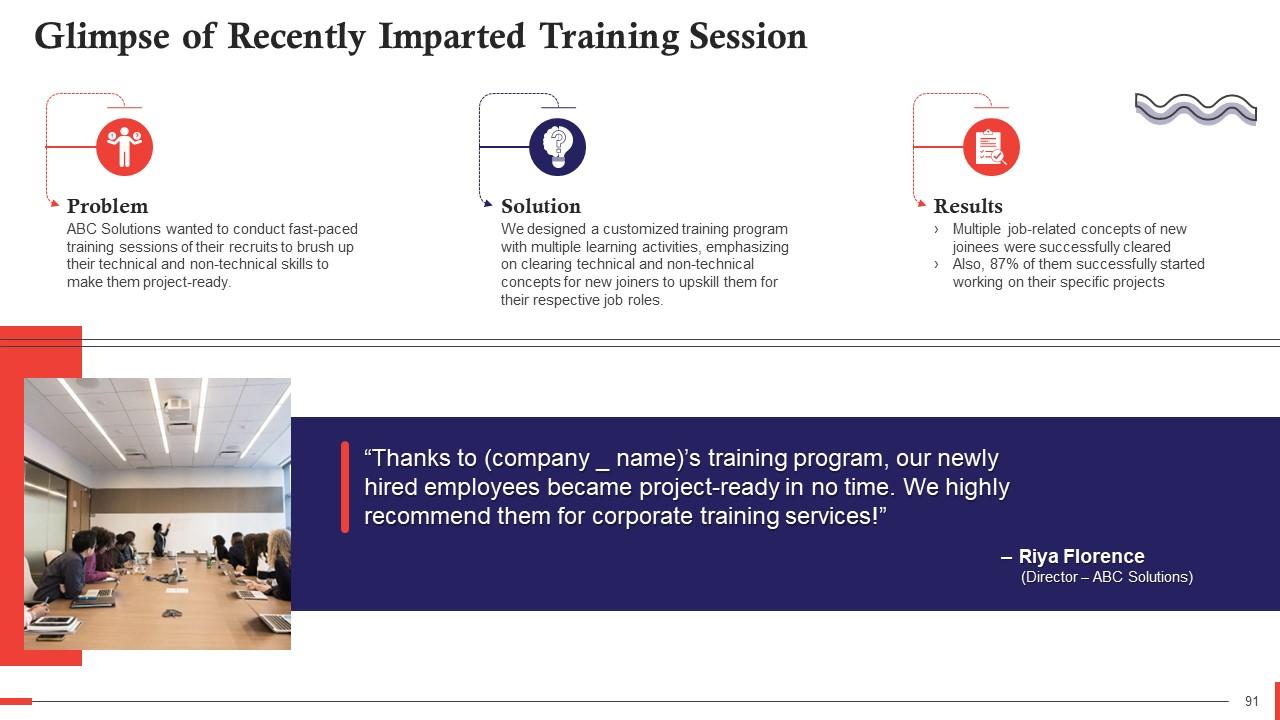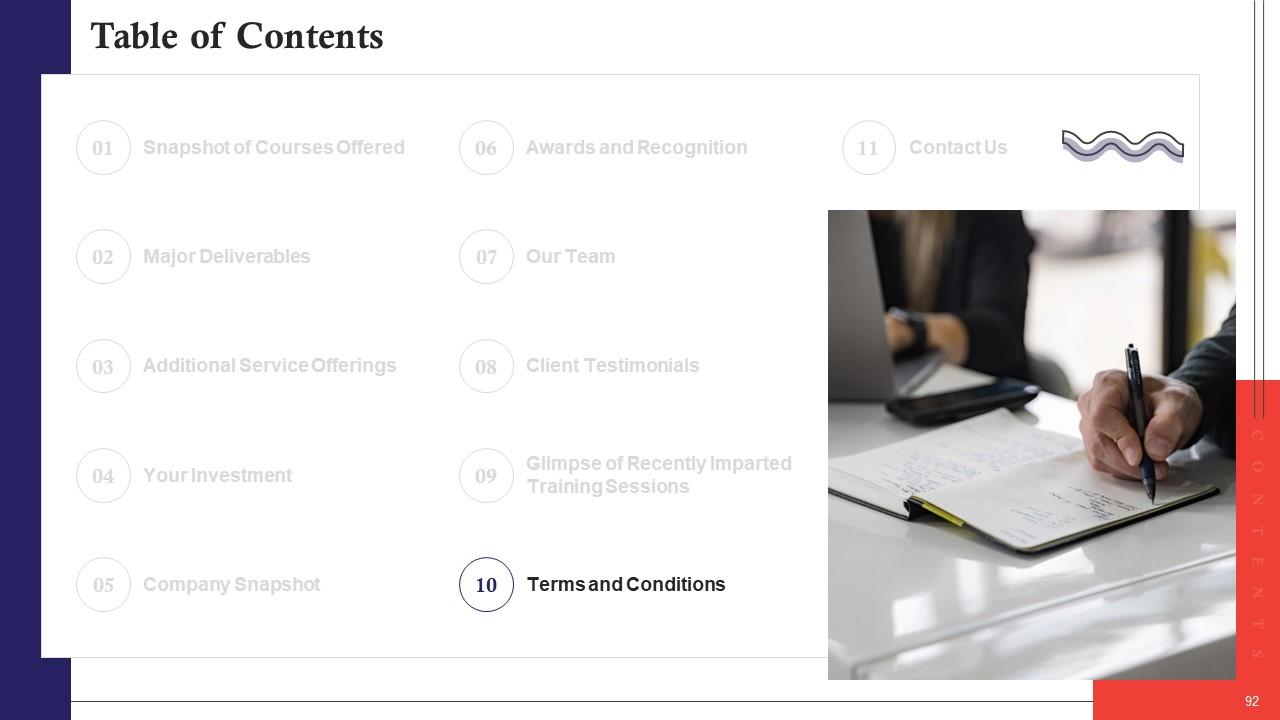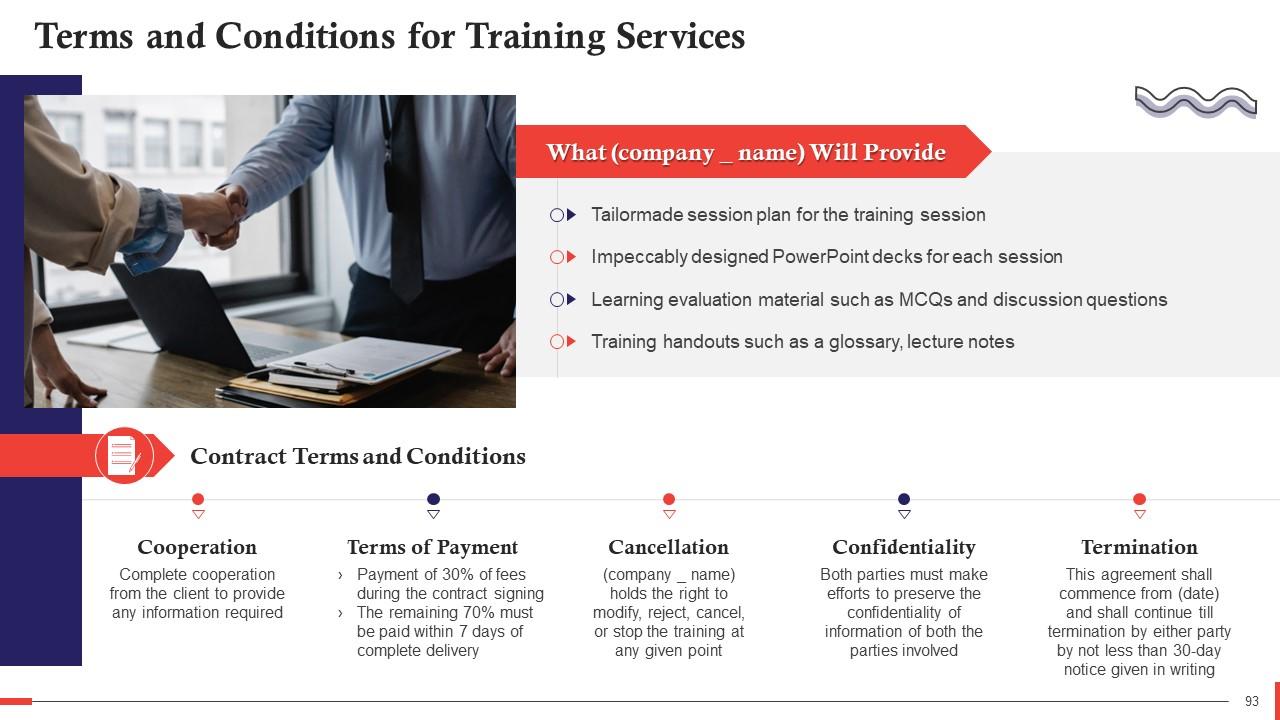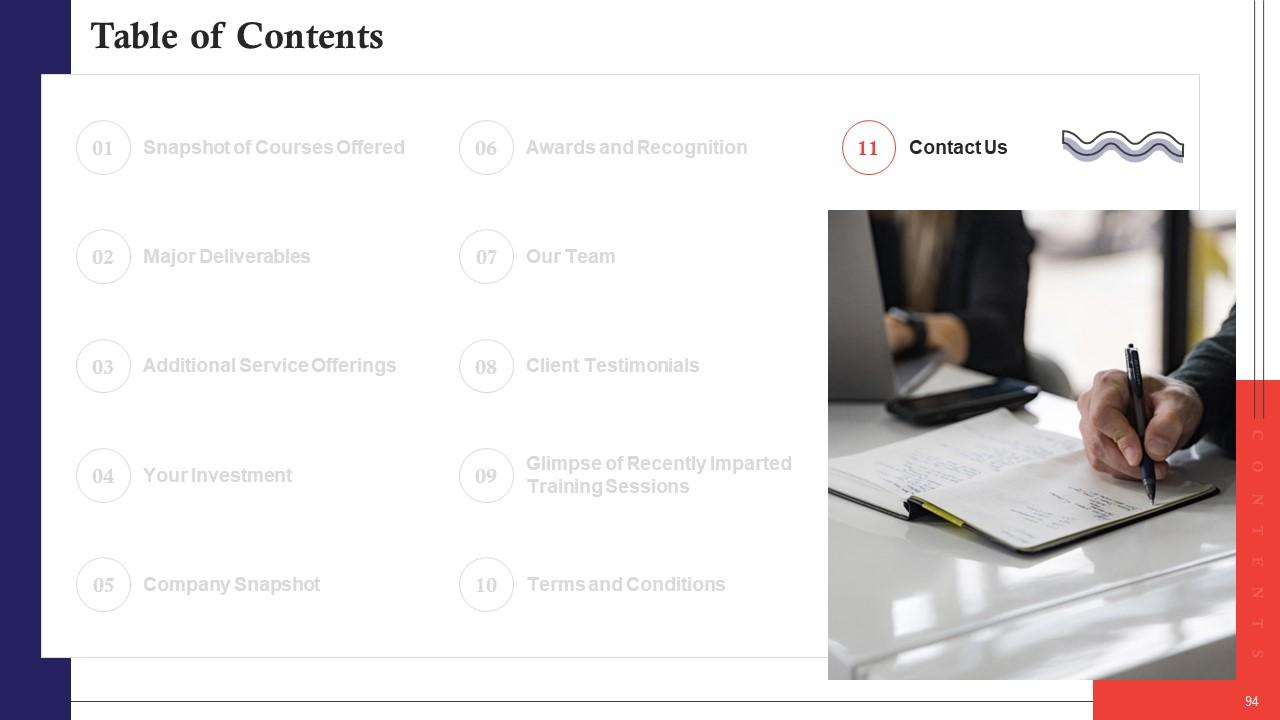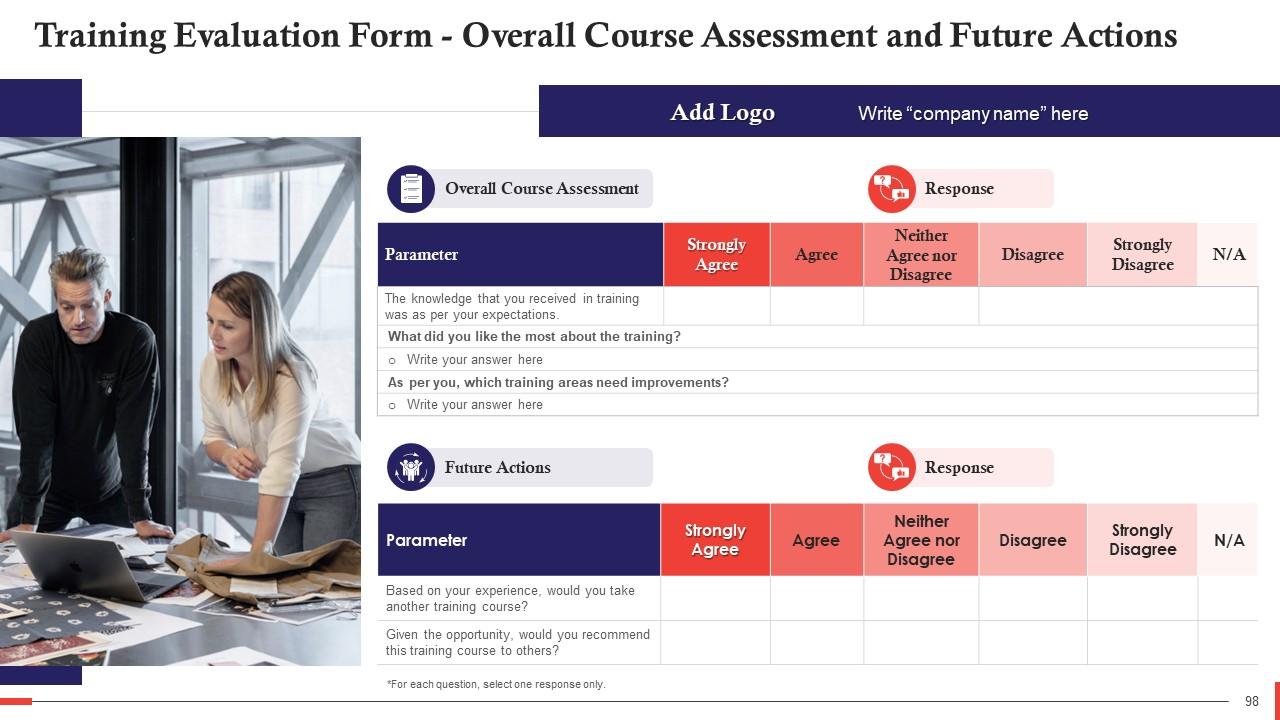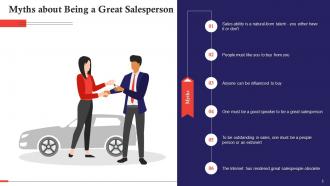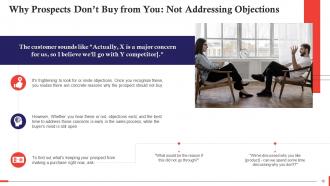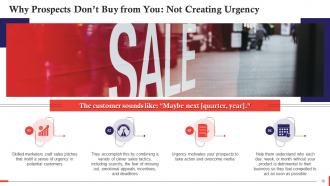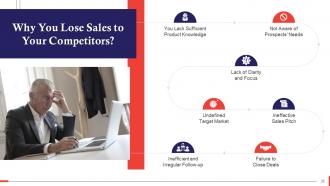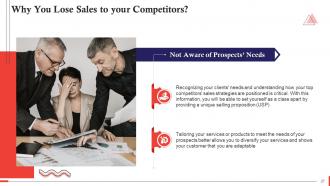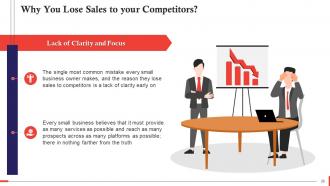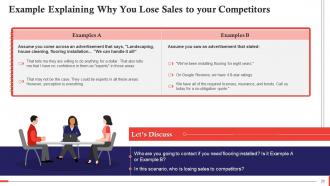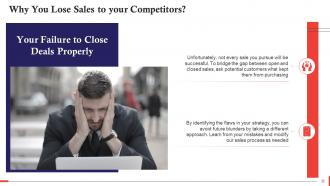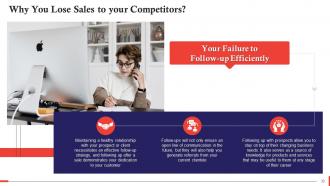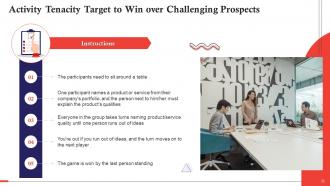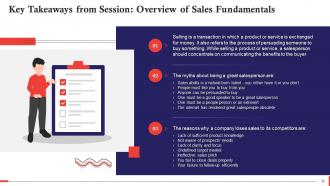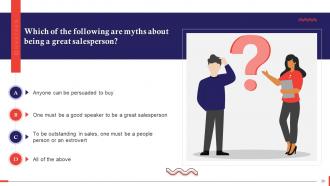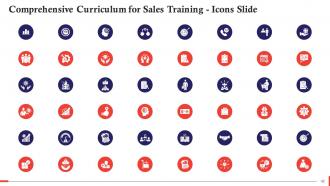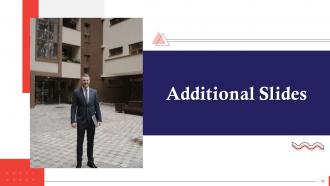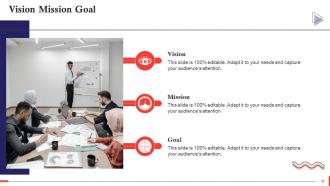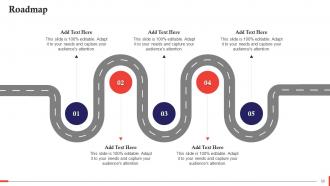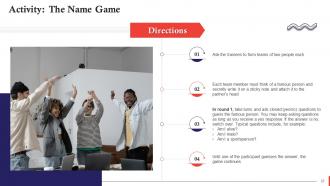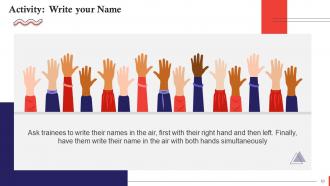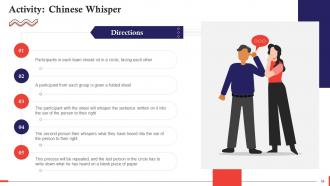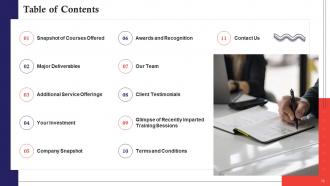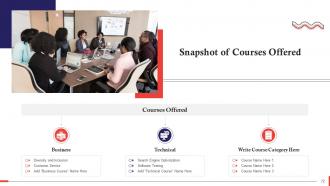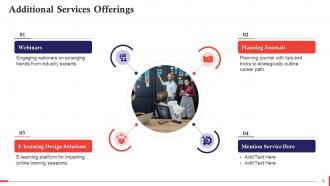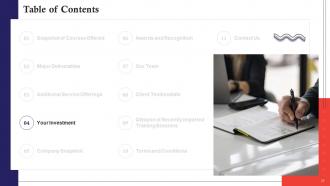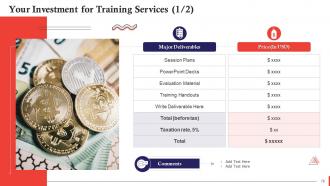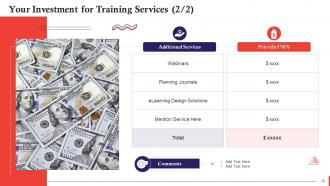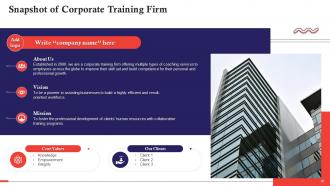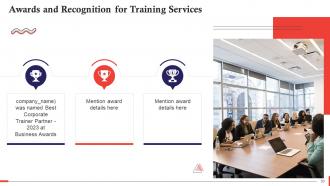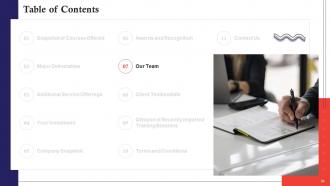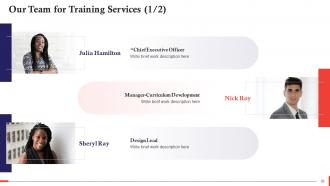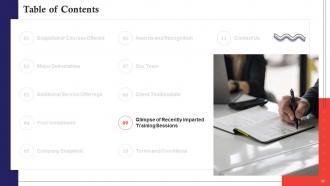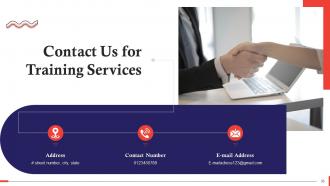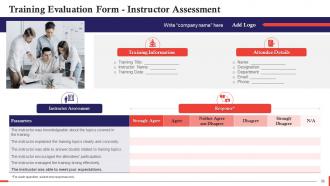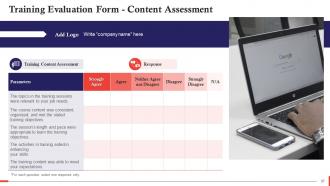Overview Of Sales Fundamentals Training Ppt
This training module on Overview of Sales Fundamentals comprehensively covers the concept of Selling, Myths about Being a Great Salesperson, and Reasons Salespeople Fail Not Knowing the Product and Competition Not Listening, Not Understanding the Value Proposition, Inconsistency, Lack of Follow-up, Not Setting Daily Goals. Then it includes How to Sell the Way Your Prospects Buy Make a List of All the Features of the Product and Service and their Usability and How to Find Out What Prospects Actually Want. Request New Product or Service Ideas From your Current Customers, Request Feedback From Your Current Customers on the Products They are Currently Using Not Yours, Enquire about Prospects Significant Problems or Issues, Attend Trade-shows and Seminars. Further, in detail, it covers Why Dont Prospects Buy from You. Trying to Sell to Everyone, Not Selling Value, Not Listening to Prospects, Not Addressing Objections, Not Creating Urgency, Dysfunctional Sales Process, You May Be Driving Customers Away and Why You Lose Sales to Your Competitors You Lack Sufficient Product Knowledge, Not Aware of Prospects Needs, Lack of Clarity and Focus, Undefined Target Market, Ineffective Sales Pitch, Inefficient and Irregular Follow-up, Failure to Close Deals. It also includes the Activity, Key Takeaways, and Discussion Questions related to the topic to make the coaching session more interactive. The deck has PPT slides on About Us, Vision, Mission, Goal, 30-60-90 Days Plan, Timeline, Roadmap, Training Completion Certificate, and Energizer Activities. It also includes a Client Proposal and Assessment Form for training evaluation.
- Google Slides is a new FREE Presentation software from Google.
- All our content is 100% compatible with Google Slides.
- Just download our designs, and upload them to Google Slides and they will work automatically.
- Amaze your audience with SlideTeam and Google Slides.
-
Want Changes to This PPT Slide? Check out our Presentation Design Services
- WideScreen Aspect ratio is becoming a very popular format. When you download this product, the downloaded ZIP will contain this product in both standard and widescreen format.
-

- Some older products that we have may only be in standard format, but they can easily be converted to widescreen.
- To do this, please open the SlideTeam product in Powerpoint, and go to
- Design ( On the top bar) -> Page Setup -> and select "On-screen Show (16:9)” in the drop down for "Slides Sized for".
- The slide or theme will change to widescreen, and all graphics will adjust automatically. You can similarly convert our content to any other desired screen aspect ratio.
Compatible With Google Slides

Get This In WideScreen
You must be logged in to download this presentation.
PowerPoint presentation slides
Presenting Training Deck on Overview of Sales Fundamentals. This deck comprises of 98 slides. Each slide is well crafted and designed by our PowerPoint experts. This PPT presentation is thoroughly researched by the experts, and every slide consists of appropriate content. All slides are customizable. You can add or delete the content as per your need. Not just this, you can also make the required changes in the charts and graphs. Download this professionally designed business presentation, add your content and present it with confidence.
People who downloaded this PowerPoint presentation also viewed the following :
Content of this Powerpoint Presentation
Slide 4
This slide explains the concept of selling. It highlights that selling is a transaction in which a product or service is exchanged for money. It also refers to sales as the process of convincing someone to buy something. While selling something, a salesperson should concentrate on communicating the benefits to the buyer. It also mentions that these days, adults have an average attention span of eight seconds, which means a salesperson has little time to capture the attention of their prospects. To be an effective salesperson, one must have a strong message and deliver it to the right people at the right time.
Slide 5
This slide depicts the myths about being a great salesperson. The Myths are: Sales ability is a natural-born talent - you either have it or don’t, people must like you to buy from you, anyone can be persuaded to buy, one must be a good speaker to be a great salesperson, one must be a people person or an extrovert, Lastly, the widely-held notion that the internet has rendered sales people obsolete is also wrong.
Slide 6
This slide lists the reasons for salespersons’ failure. The reasons are: Not knowing the product and competition, not listening, not understanding the value proposition, inconsistency, lack of follow-up, and not setting daily goals.
Instructor’s Notes:
Reasons salesperson fail are:
- Not Knowing the Product and Competition: One of the main reasons sales people fail is lack of knowledge of their products and competition. Product knowledge is essential for success in any industry. In addition to knowing your product, you must also know your competitors to demonstrate your competitive advantage to prospects
- Not Listening: One of the most overlooked sales skills is the ability to listen. Some sales representatives spend far too much time talking and too little time listening to the customer. The customer will usually tell everything a salesperson must know to close the deal if he/she listens carefully
- Not Understanding the Value Proposition: Sales is about creating value, but many salespeople are obsessed with closing the deal at any cost. To create value for your customer, you must be able to map the benefits of your product to the customer's business challenges
- Inconsistency: Those who excel in sales understand that consistency is the key to a prosperous career. The ups and downs can be stressful, but the best salespeople compensate for the lows with huge highs ensure consistent performance
- Lack of Follow-up: There are numerous reasons why salespeople fail to follow up with qualified prospects. Sometimes they attempt not to be too pushy, and other times they forget. Whatever the reason, follow-up is frequently neglected, and sales are lost
- Not Setting Daily Goals: Every salesperson has a company provided sales goal, but not everyone sets attainable daily or weekly goals to work toward that larger goal. The most successful salespeople understand how much prospecting, calling, pitching, and following up is required to achieve their overall goal and plan their days in this light
Slide 8
This slide provides key sales statistics. The statistics depict the significance of follow-up, customer referrals, and knowing your customer needs.
Slide 9
This slide mentions information regarding how to find out what prospects actually want to buy. It highlights that a salesperson must make a list of all the features and the list of the benefits of the product/service.
Instructor’s Notes:
You'll have to keep refining and adding to the list you've created. You start by making educated guesses by imagining yourself as a prospect using your product/service. As you interact with more prospects, answering these questions will teach you more about what is important to them. And you'll soon be able to spot patterns and understand your prospect's true thoughts and feelings.
Slide 11
This slide mentions ways to discover what your prospects actually want to buy. These are: Request new product or service ideas from your current customers, Request feedback from your current customers on the products they are currently using (not yours), Enquire about prospects’ significant problems or issues, and Attend trade-shows and seminars.
Slide 12
This slide discusses how soliciting new product/service ideas from current customers can help you figure out what your prospects want. It emphasizes that it is one of the most prominent and effective methods. Ask your current customers, email subscribers, and social media followers if they have any suggestions for new products or services that are needed or would be useful to them.
Slide 13
This slide explains how asking your prospects for feedback on the products they are using can help you figure out what they want. It emphasizes that this strategy is frequently overlooked, but this information can be priceless. While surveying prospects, instead of asking them about your products or services, ask what they buy from other companies and how they feel about those. It also states that this will give you an insight into what your customers are purchasing and how you can tempt them to buy from you.
Slide 14
This slide explains how a prospect's significant problems or issues can aid in determining what they want. It mentions that asking your subscribers or followers for product recommendations will not always work because they may be unable to articulate precisely what they need. However, they will be able to tell you about their most pressing issue, problem, or pain point. With this information, You can better tailor your product offerings to customers' needs with this information.
Slide 15
This slide explains how attending trade-shows and seminars can assist salespersons in determining what their prospects want. It emphasizes the importance of meeting with customers informally. It also emphasizes that customer and prospect seminars have long been recognized as effective marketing tools. Seminars can assist you in getting to know your prospects while also informing them about your product or service. A simple question-and-answer session can help a salesperson get important information about their concerns and desires.
Slide 16
This slide mentions the reasons customers do not buy from you. The reasons are: Trying to sell to everyone, not addressing objections, not creating urgency, not selling value, not listening to prospects, a dysfunctional sales process, and salespersons actually driving customer customers away.
Slide 17
This slide explains why customers do not buy as salespeople try to sell to everyone. It underlines the importance of quality over quantity in a promising sales pipeline. If prospects aren't buying from you, consider the quality of your opportunities. We also learn that, while it may seem counterintuitive to reject anyone, narrowing the most qualified prospects will increase chances of success.
Slide 18
This slide depicts the reason why prospects do not buy from you, which is because salespeople do not address objections. It mentions how frightening it is to look for objections. Once identified, there are specific reasons why the prospect should not buy. Objections exist whether you hear them or not, and the best time to address them is early in the sales process, while the buyer still has an open mind.
Slide 19
This slide discusses the reason prospects do not buy from you, which is a lack of urgency. It emphasizes how skilled marketers craft sales pitches that create a sense of urgency in potential customers. They achieve this by combining a number of deft sales techniques, such as scarcity, the fear of missing out, emotional appeals, incentives, and deadlines. It also highlights the importance of urgency in motivating your prospects to act and overcome inertia.
Slide 20
This slide discusses why prospects do not buy from you, which is your failure to create value. It emphasizes that as a sales professional, you don't sell products and services; you sell the value these products and services can provide to the end-user. Buyers aren't concerned with the product's characteristics; instead, they are concerned with how that product or feature will make their lives easier. It also highlights that when you sell the product's value, you're positioning your offer as something the prospect can't live without or ignore.
Slide 21
This slide explains why prospects do not buy from you because you are not listening to them. It emphasizes the importance of active listening for salespeople. If your prospect says at the end of your sales process, “This isn't what I'm looking for," you missed an opportunity to hear their point of view somewhere along the way. It also mentions that incorporating active listening practices into your sales conversations will likely yield better results if your conversations with prospects are one-sided (meaning only you are the one talking).
Slide 22
This slide explains why prospects don't buy from you because salespeople push customers away. It emphasizes that most people avoid answering unknown number calls because they do not want to be sold to. Salespeople must avoid bothering their prospects and provide genuine value. It might be better to consider yourself as a consultant rather than a salesperson.
Slide 23
This slide discusses why prospects do not purchase from you due to dysfunctional sales process. It emphasizes that if many prospects do not progress far enough through your sales process to a closure, either your sales process is dysfunctional or your funnel has a leak that must be repaired. This could indicate that your prospects are not being properly qualified or that an opportunity to follow up on and nurture qualified leads has passed you by. It also mentions that salespeople can work with their team to go through the sales process with a fine-tooth comb and identify areas where buyer experience can be improved.
Slide 25
This slide depicts the reasons why a company loses sales to its competitors. The reasons are: Lack sufficient product knowledge, not aware of prospects’ needs, lack of clarity and focus, undefined target market, ineffective sales pitch, failure to close deals and, and inefficient and irregular follow-up of leads.
Slide 26
This slide discusses the reason for sales failure which is "Lack Sufficient Product Knowledge." It emphasizes that you've already lost the sale if you can't fully explain how your products and services will benefit your prospects. It also mentions how a lack of product/service knowledge creates uncertainty and damages your already-tentative relationship with your prospects.
Slide 27
This slide discusses the reason for sales failure, which is "Not Aware of Prospects’ Needs" It emphasizes the importance of understanding your clients' needs and how your top competitors' sales strategies are positioned. With this information, you will be able to differentiate yourself with the Unique Selling Proposition (USP) you offer. It also states that tailoring your services or products to better meet the needs of your prospects allows you to diversify your services and demonstrates to your customers that you are adaptable.
Slide 28
This slide depicts the reasons why a company loses sales to its competitors. It emphasizes that a lack of clarity and focus early on is the single most common mistake that nearly every small business makes and why they lose sales to competitors. Every small business believes it must provide as many services and reach as many prospects as possible across as many platforms as possible. Nothing is farther from the truth than this.
Slide 29
This slide mentions an example explaining why you lose sales to you competitors.
Instructor’s Notes:
Perception tells us that the flooring company in Example B is unquestionably superior. Why? Because they are experts at only one thing. If you want to ensure that you capitalize on every sale opportunity and that you are the "expert" in your market, you must ensure that your marketing message is not cluttered. Your marketing message should clearly state that you are an expert in ONE area.
Slide 30
This slide discusses "Undefined Target Market" as the reason for sales failure." It highlights that if your revenue targets aren't being met, it's time to reconsider your target market. To begin, divide your current customers into segments. This will allow you to identify the similarities and differences between your customer groups. As a result, one can identify which aspects of the offer appeal to each group, allowing you to tailor your services or product to meet their needs.
Slide 31
This slide depicts the reason for sales failure, which is “Ineffective Sales Pitch “. It emphasizes that you must incorporate customization in your sales pitch and not have one-size-fits-all presentation. Customers' needs and desires change frequently, and so should your sales pitch. It also mentions that tailoring your pitch to the individual and the situation they are in ensures that you meet their needs because every prospect is different.
Slide 32
This slide discusses the reason for sales failure: "Your Failure to Close Deals Properly." It depicts that not every sale you pursue will be successful. Ask potential customers what kept them from purchasing to bridge the gap between open and closed sales. It also mentions that identifying flaws in your strategy will help you avoid future blunders. One must learn from mistakes and make necessary changes to the sales process.
Slide 33
This slide discusses the reason for sales failure: "You Fail to Follow-up Efficiently." It emphasizes that maintaining a healthy relationship with your prospect or client necessitates an effective follow-up strategy, and following up after a sale demonstrates your commitment to your customer. It also mentions that follow-ups will not only ensure an open line of communication in the future but will also help you generate referrals from your current clientele.
Slide 34
This slide explains the reason for sales failure, which is "Not Calculating the Cost Value of Your Products Correctly." It emphasizes that you could be losing sales due to the low-cost value of your current products. Because no two customers are alike, you must constantly re-evaluate which products/services provide the most suitable value return to each of your unique customers. It also states that a one-size-fits-all sales approach is never appropriate.
Slide 35
This slide showcases an activity named “Tenacity Target,” which the trainer can conduct in the training session.
Instructor’s Notes:
Objective:
Sales professionals frequently encounter prospects who are challenging to sell to. To win over some difficult customers, you must have a lot of endurance, empathy, and soft skills. The Tenacity Target game trains sellers to have the right attitude and stamina to deal with a challenging prospect and win over customers.
Learning:
- Learn to be inventive when it comes to coming up with persuasive ideas
- Describe your offer in terms that varied target groups can understand
Slide 52 to 67
These slides contain energizer activities to engage the audience of the training session.
Slide 68 to 95
These slides contain a training proposal covering what the company providing corporate training can accomplish for the client.
Slide 96 to 98
These slides include a training evaluation form for instructor, content and course assessment.
Overview Of Sales Fundamentals Training Ppt with all 103 slides:
Use our Overview Of Sales Fundamentals Training Ppt to effectively help you save your valuable time. They are readymade to fit into any presentation structure.
-
SlideTeam’s readymade presentations have landed my unique images with my bosses in the past and it continues to reward me.
-
The information is visually stunning and easy to understand, making it perfect for any business person. So I would highly recommend you purchase this PPT design now!


